64 Gothic Living Room Arches and Windows: Elegant Design Ideas
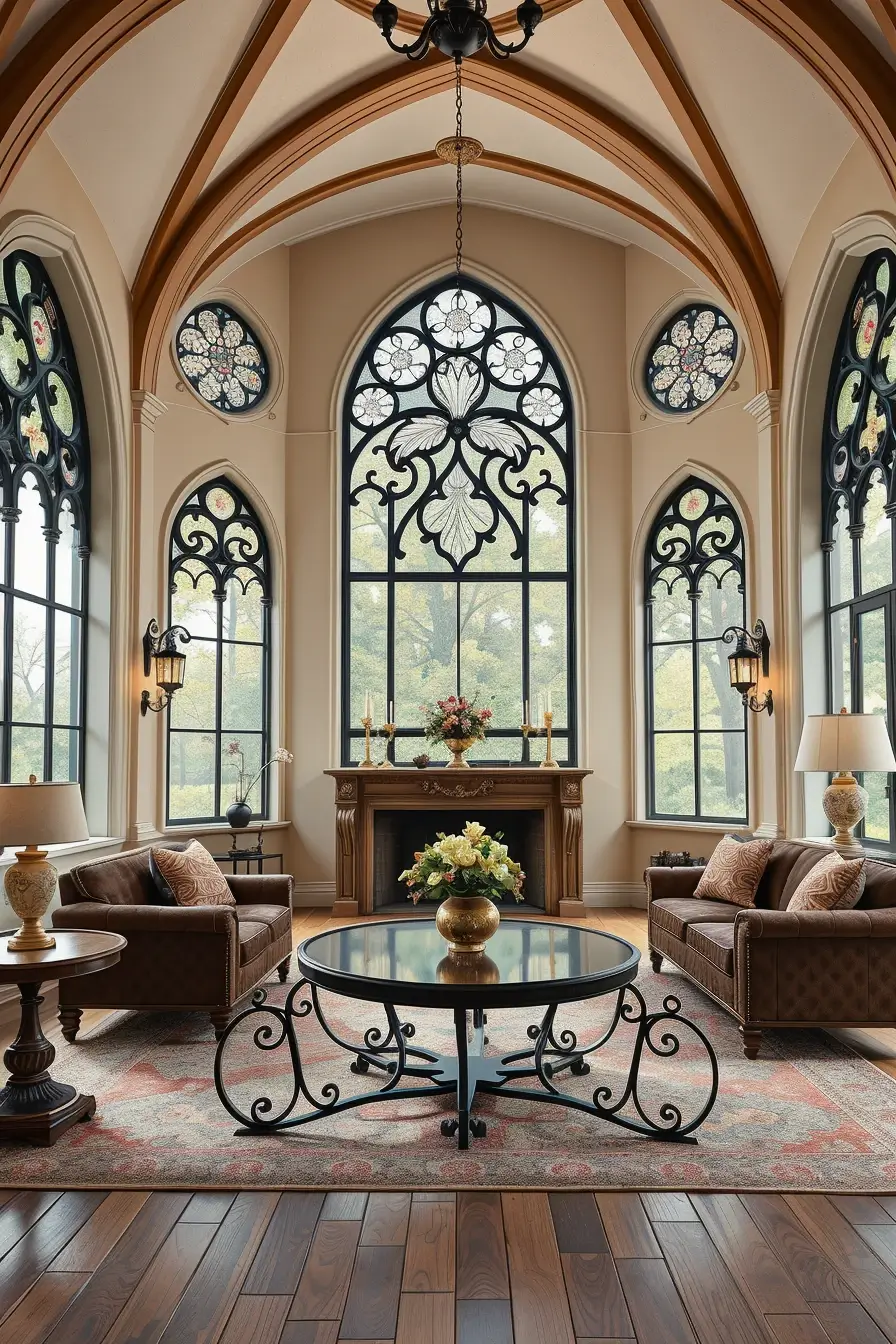
One of the things I consider when I want to create a living room that looks classic and yet expressive is the use of gothic living room arches and windows. What is so strong about these design elements? How do they make a space feel dramatic and yet welcoming, historic and modern? In this article, I will show how to add gothic arches and windows to a living room and strike the right balance between them and furniture, textures, and decor items to make the room functional and stylish.
At the end, you will find out how these features can utterly transform a living space and why they are so lasting in architecture and interior design. Whether it is pointed arches or stained glass, every decision enhances a home with depth and atmosphere. I have also added some ideas based on interior designers and magazines that pointed out the gothic details as a major way of creating elegance and drama in contemporary settings.
Gothic Living Room Arches And Windows: A Timeless Statement
I think that gothic arches and windows are not just architectural details, they form a story in the living room. The angular shapes of the arches lead the eye upwards, giving the sense of height and grandeur, and the windows introduce natural light through the elaborate frames. These facts are eternal since they represent history and art in one, and they perfectly fit in contemporary interiors when properly designed.
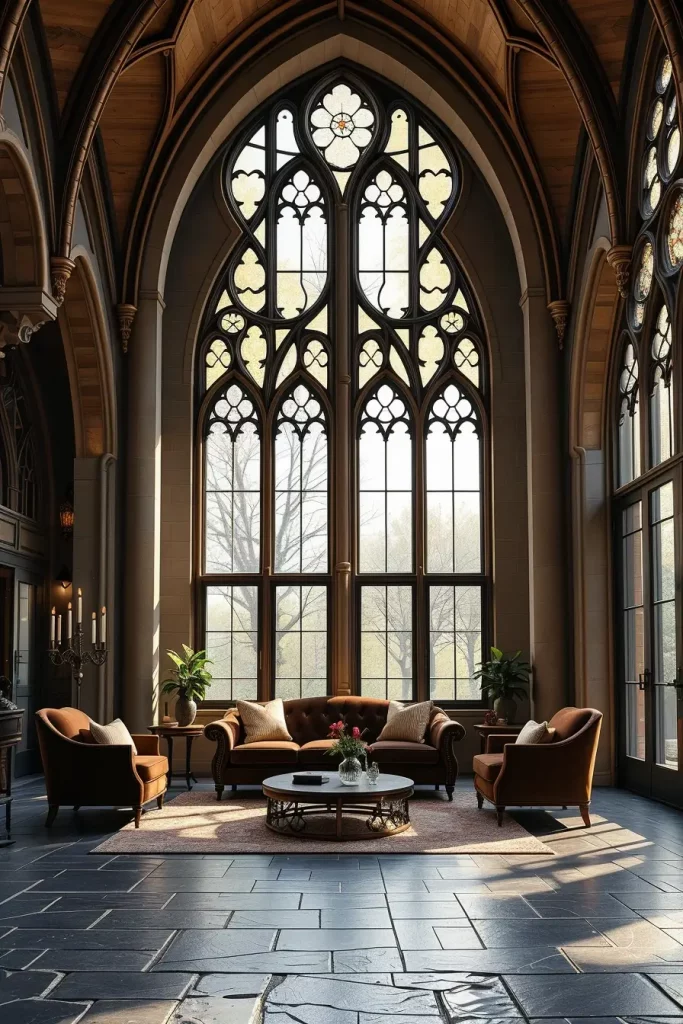
I would use heavy wooden furniture with carvings, dark-colored upholstery such as velvet, and accessories that complement the medieval style but do not make the room look cluttered. As an example, a dark oak coffee table and iron candleholders will go well with the gothic frames but still be functional.
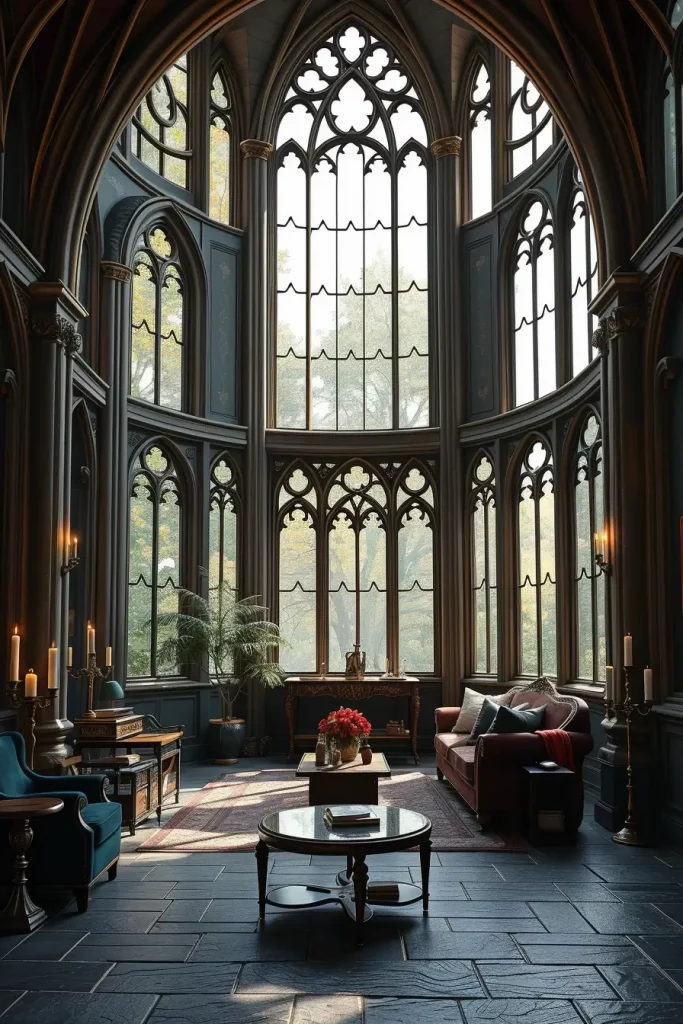
I have always been impressed with the way that gothic elements can transform the atmosphere of a room. I remember reading in Architectural Digest that the gothic design has the capacity to combine structure and art which is what makes it relevant. That is the view that I share: the arches are sculptural in themselves, so architecture is a kind of built-in decor.
The only thing I would add here is the flooring, which should also contribute to the overall effect, such as stone or dark-colored wood floors, which will help the arches and windows not to feel out of place.
The Allure Of Gothic Arches In Interior Design
I tend to incorporate gothic arches in interiors because they have the inherent capacity to make an interior look distinguished and sophisticated. The arch is not only ornamental but practical, as it bears walls, frames the views, and throws the light in beautiful lines. These arches provide a feeling of permanence and weight in a living room that can anchor even the most modern furnishings.
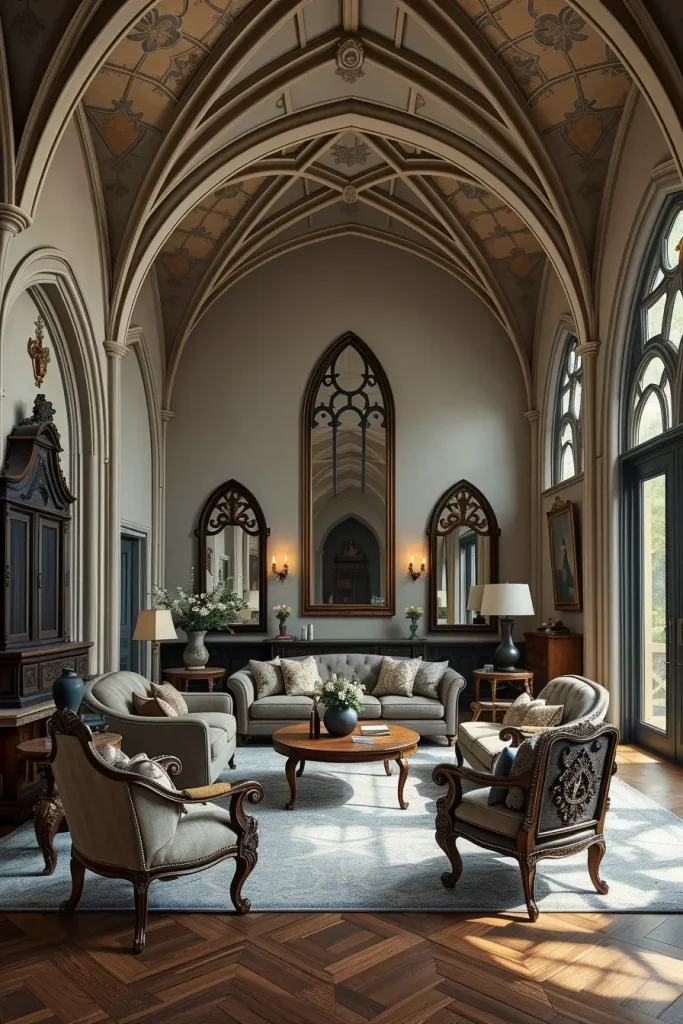
To complement their presence, I prefer to match the arches with a compatible furniture. As an example, arched bookcases, cathedral-style mirrors, and curved sofas are similar to the architectural lines, thus, creating harmony. The arches are also balanced with the dark leather seating or velvet armchairs that are comfortable.
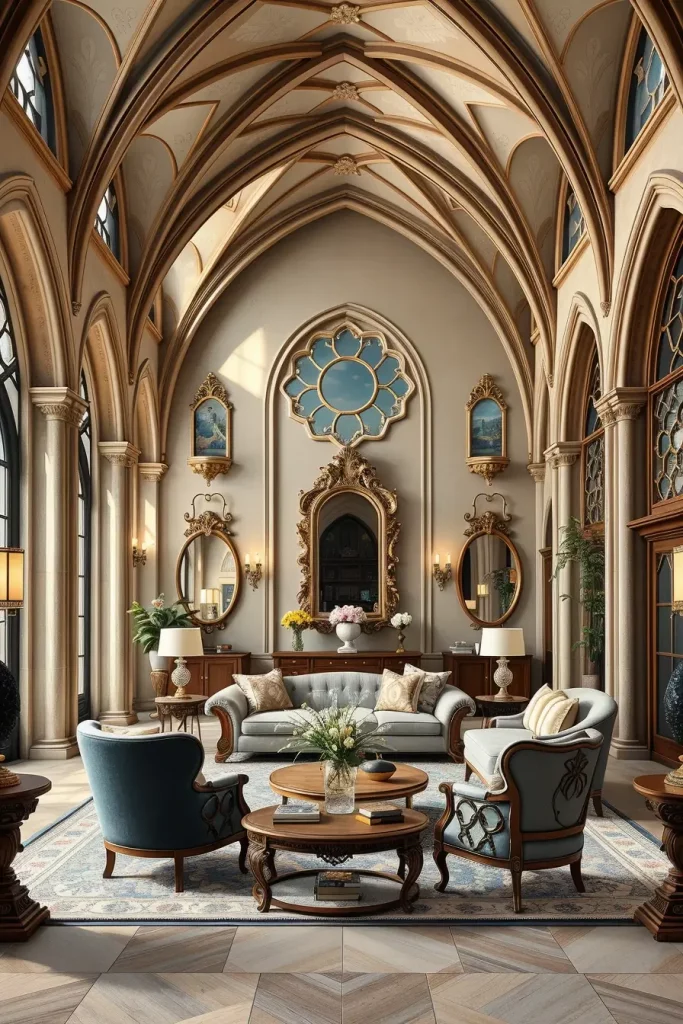
To my mind, gothic arches are calming, as they are symmetrical. I have read design features in Elle Decor where arches are accented with low-level lighting to create a more evening atmosphere and I think that little addition makes a world of difference.
The only thing I would add here is textured wall finishes, like limewash or plaster, to accentuate the historic nature of the arches without overpowering them.
Creating Drama With Pointed Arch Windows
One of the most impressive features of gothic architecture to my mind is the pointed arch windows. They immediately attract attention, and the window becomes the center of the living room. The pointed arch is such that it creates an illusion of height, elegance and refinement even in a small room.
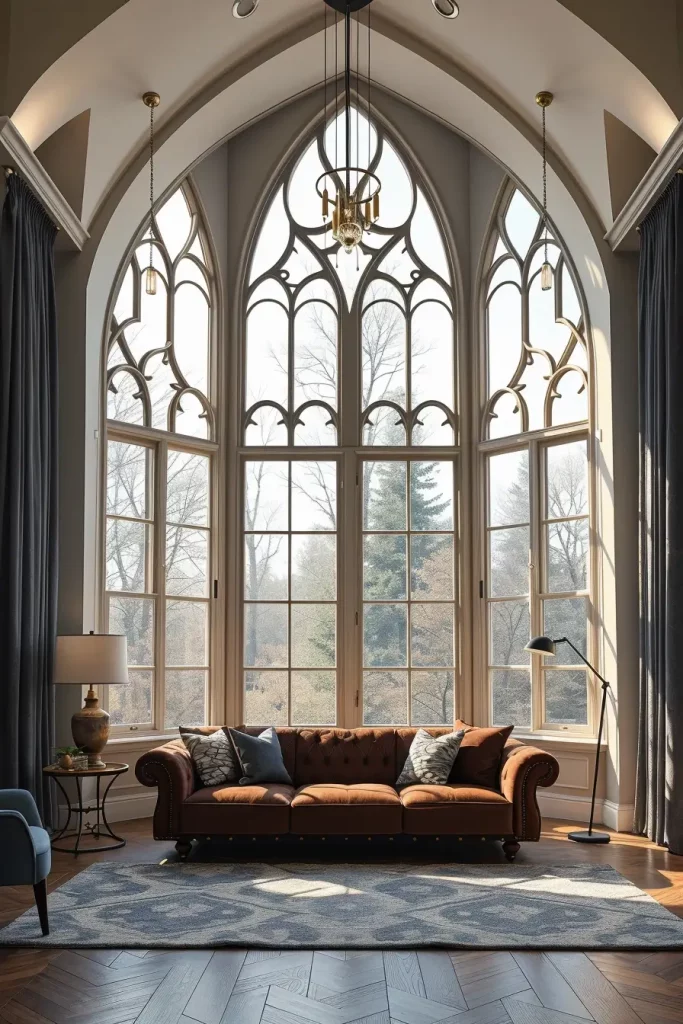
When decorating around pointed arch windows, I tend to use furniture with vertical accent- tall shelving, long drapery, and narrow lighting. A deep velvet sofa that is positioned under such a window forms a contrast that adds to the grandeur of the room.
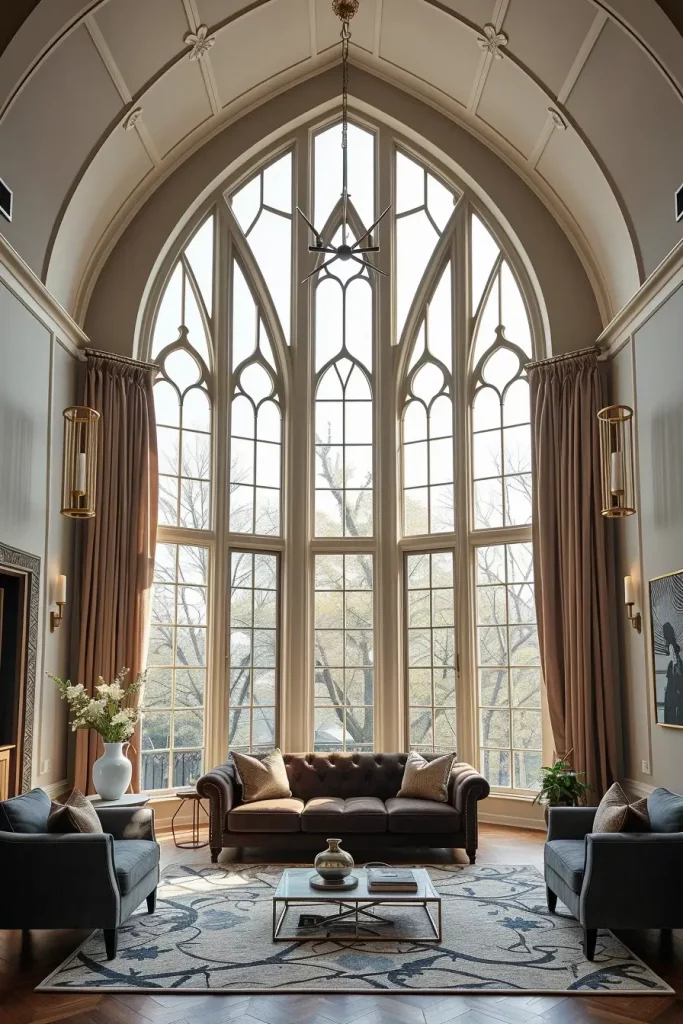
These windows always seemed to be transformative to me. House Beautiful once referred to them as architectural jewelry and I couldn t agree more. They do not need much more to shine, but I think that properly chosen artwork and decoration around them can make them even more beautiful.
The one thing I would add to this section would be the use of neutral wall color-like soft gray or ivory- to allow the shape of the windows to become the center of attention in the design.
Tall Windows That Draw The Eye Upward
In gothic-inspired living rooms, windows are tall and the living room almost seems like a cathedral. I have witnessed personally that these windows not only allow the maximum amount of natural light to enter but also emphasize the height of the ceiling, which makes the space feel larger and more grand.
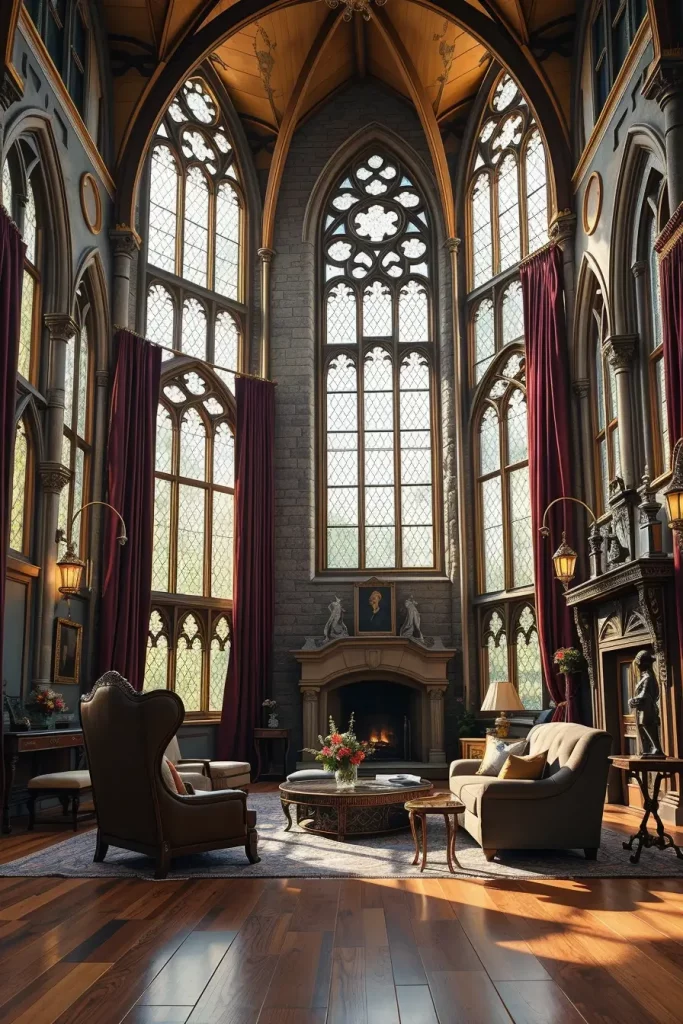
To offset such windows, I tend to select heavy pieces of furniture, such as oversized sofas, tall-back chairs and dramatic coffee tables. This avoids the windows overwhelming the rest of the interior. The heavy curtains in luxurious materials like brocade or velvet will add softness and the verticality.
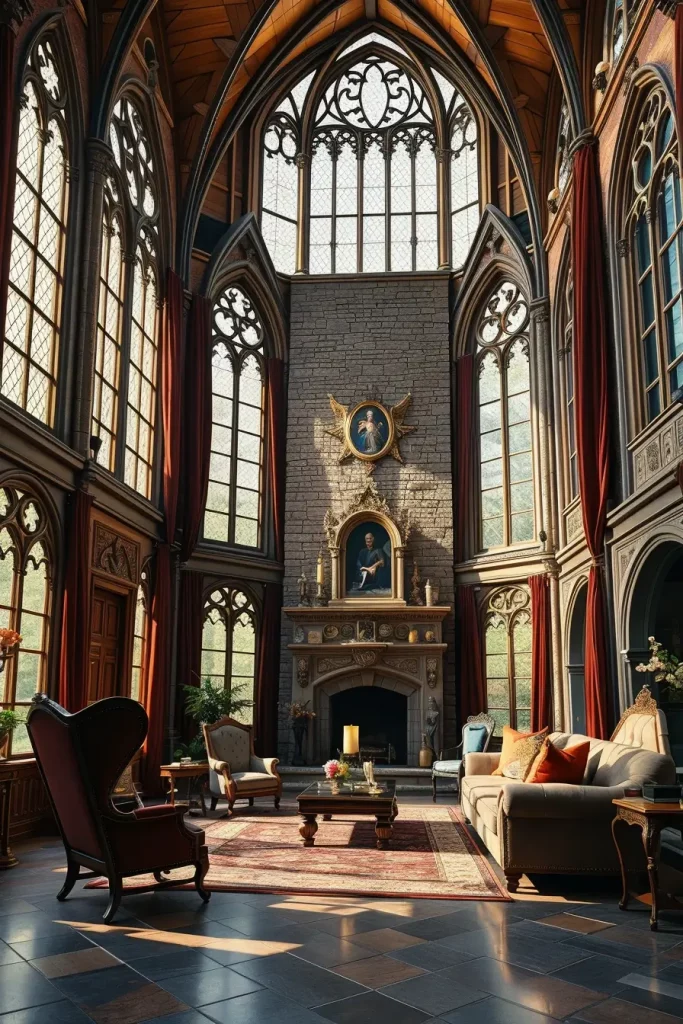
I personally like how tall windows can change the atmosphere of a room over the course of a day. They fill the room with light in the morning, and they outline the light of lamps and chandeliers at night. This is what makes them dynamic design elements.
The lack of the right proportion of art is what is usually lacking in designs with tall windows. I would suggest big wall art or tall mirrors to balance the vertical accent.
Using Stained Glass To Enhance Gothic Elegance
Stained glass is to me the supreme example of gothic art. It adds some color and light effects to the living room, immediately turning a simple window into a piece of decor. Besides the aesthetic value, stained glass offers privacy as well as letting the natural light to penetrate.
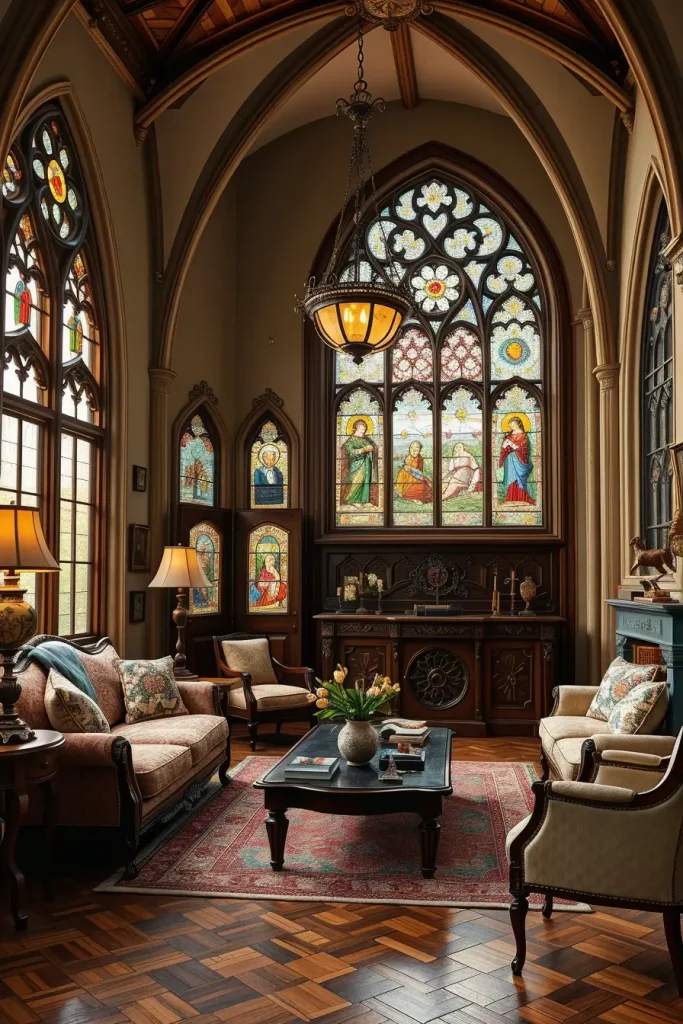
I tend to keep the other furniture plain when using stained glass in a design. The glass is the central point as the dark wood frames and neutral-toned upholstery are minimal with few accessories. A carved sideboard or an iron chandelier can give the design just a bit of gothic flair to support the design without being too much.
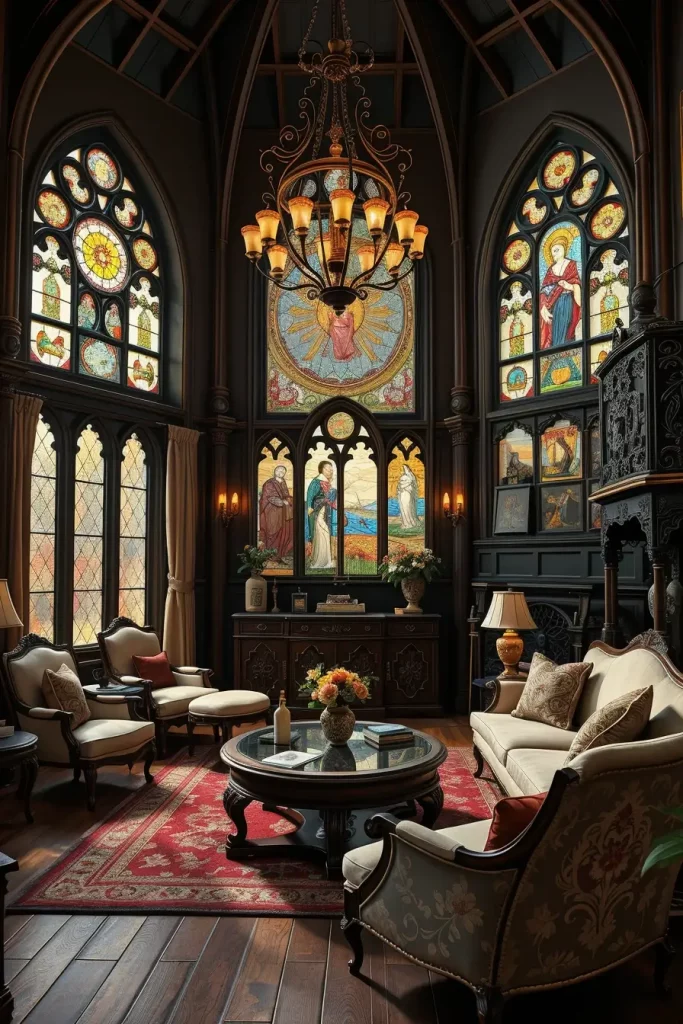
Personally, I think that stained glass looks best in combination with simple walls and floors. Stained glass is light enshrined as art, as Architectural Digest once said, and that is why I always make sure that it is a design feature by itself.
To elaborate on this part, I would suggest custom stained-glass panels. The use of modern artisans during commissioning makes the design to be unique and personal and it combines the traditional and contemporary living.
Rose Windows As A Central Living Room Feature
Rose windows are extremely daring and I think they make a good talking point in any gothic-inspired living room. They are circular which is a beautiful contrast to the linear structure of walls and furniture and creates immediate drama.
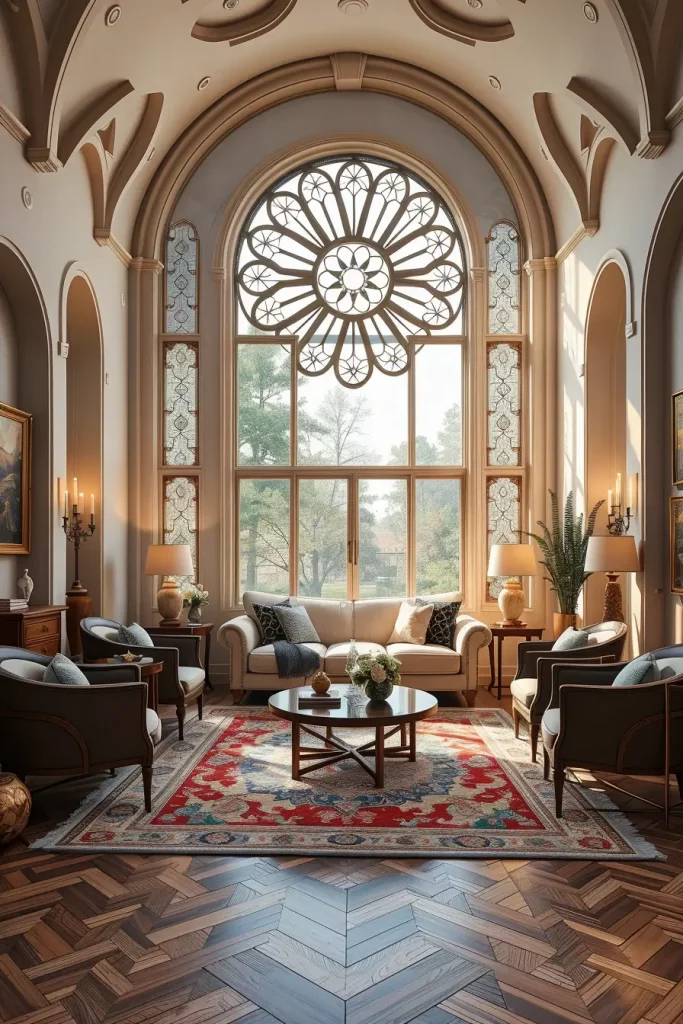
I tend to make furniture symmetrical when I am designing around a rose window. A central sofa, with matching chairs or side tables, is balanced with the window. The round shape is repeated in layered rugs and curved coffee tables, which further strengthens unity.
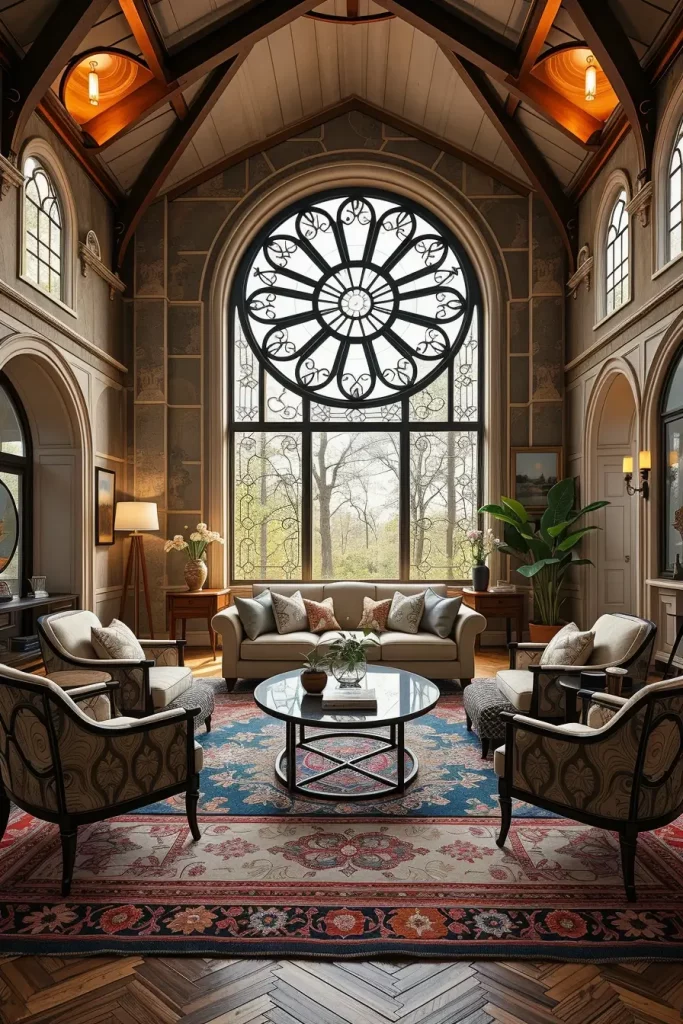
To me, rose windows provide a room with a soul. They bring in a historical feel and have a sculptural quality. I once read in Veranda that rose windows serve as the heart of a space and I wholeheartedly agree.
I would add here accent lighting that would be strategically placed to bring out the tracery of the rose window at night. This will make sure that the feature is not lost after dark.
Modern Takes On Classic Gothic Arches
Modern versions of gothic arches will enable me to use their beauty without making a room look old fashioned. The arches are more adaptable in the modern living room by using clean lines, simplified frames and lighter materials.
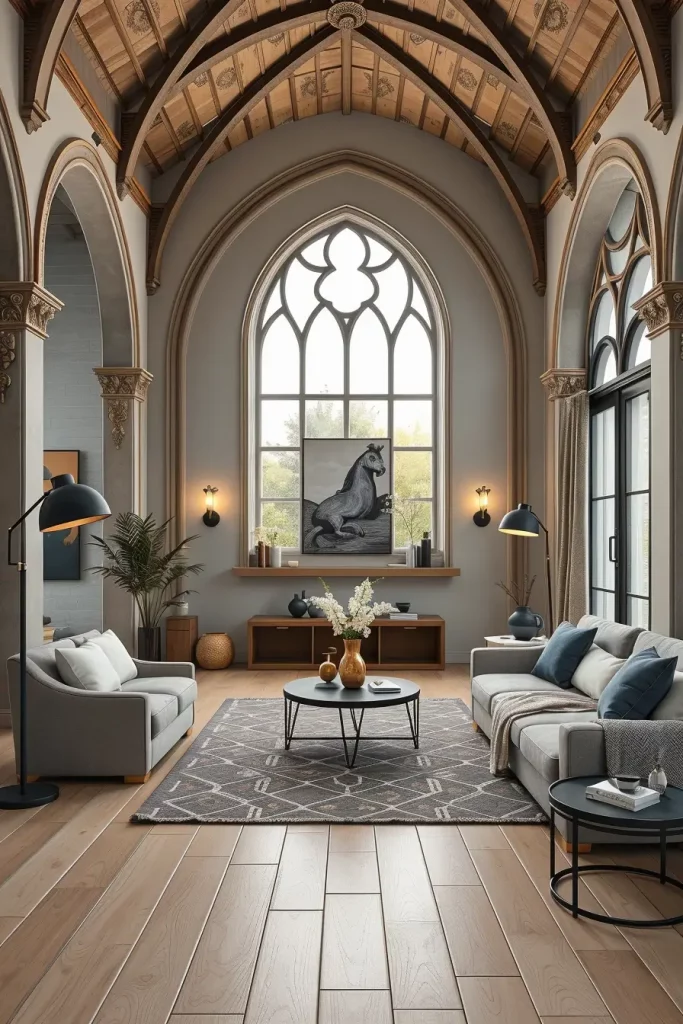
I tend to pick out sleek sofas, minimal coffee tables and muted fabrics. These options enable the gothic arches to stand out and leave the space open and not cluttered. Accessories such as simple black metal floor lamps or geometric rugs are used to give a contrast that is subtle.
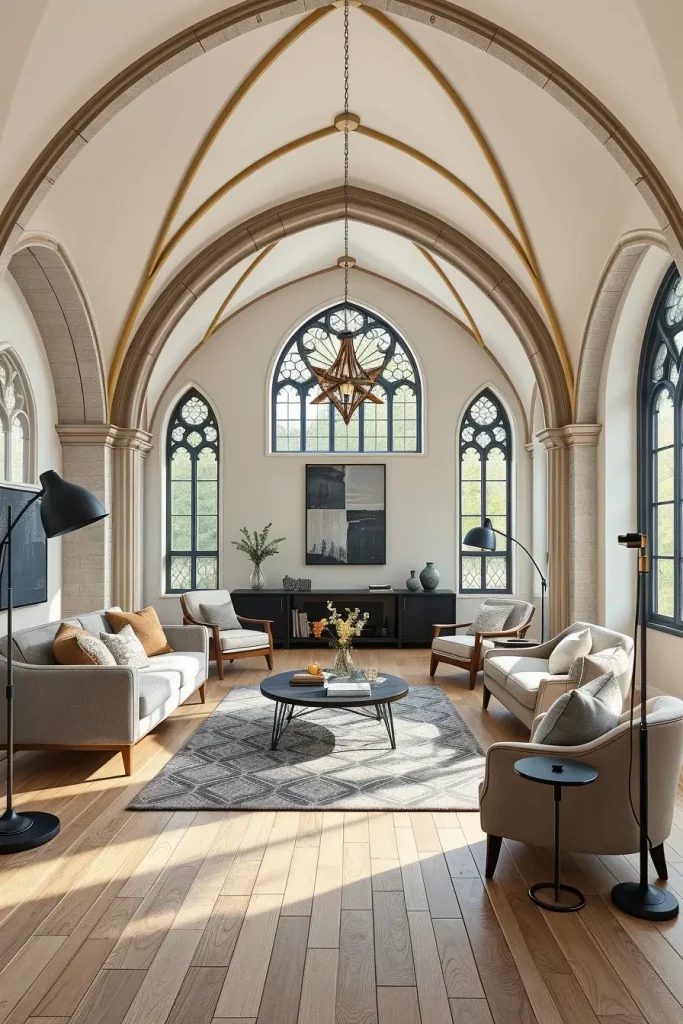
I have discovered that contemporary gothic arches bring harmony between the past and the future. Examples of the gothic form being reinterpreted with modern finishes have been seen in publications such as Dwell, and show that the gothic shape can be adapted to the modern design.
To finish off this section, I would incorporate the use of polished stone or light-coloured wood flooring to prevent the heaviness that gothic interiors can sometimes have.
Symmetry And Balance With Paired Gothic Windows
I have always liked the paired gothic windows as one of the best means of achieving harmony in a living room. The repetition of form inherently brings balance and when arranged symmetrically, they also frame the space in a way that feels deliberate and balanced. This design decision tends to make the windows a focal point of the room.
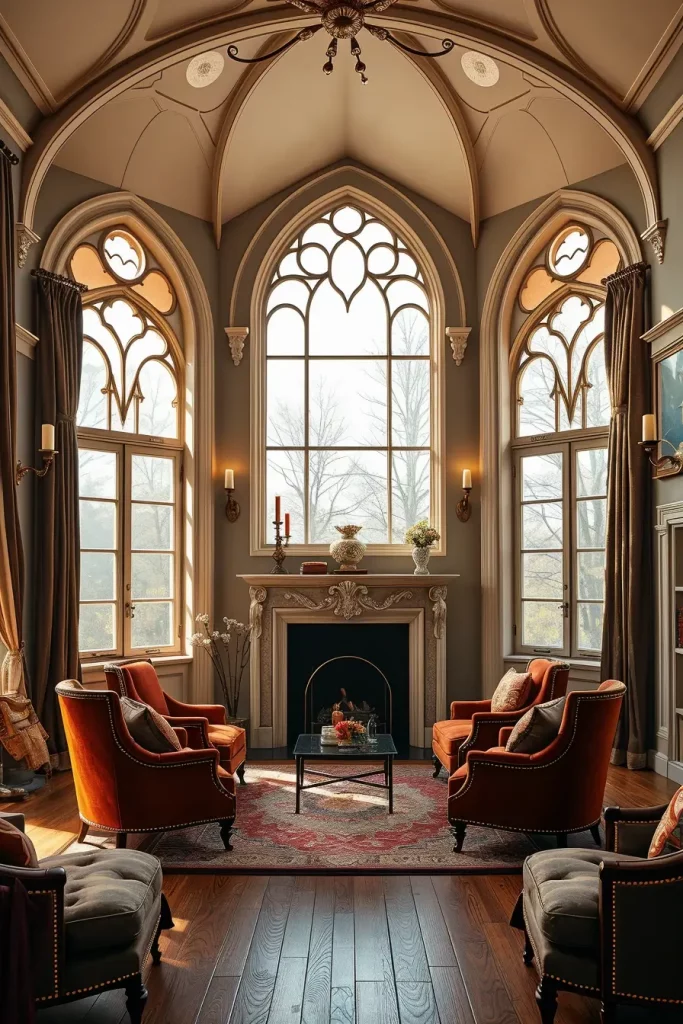
When I design around paired windows, I tend to put a focal point in the middle, like a fireplace or a large piece of art. The placement of the same armchairs or side tables on either side of the arrangement adds to the effect of symmetry. Drapery panels can be used on both sides to further the dramatic effect of the framing.
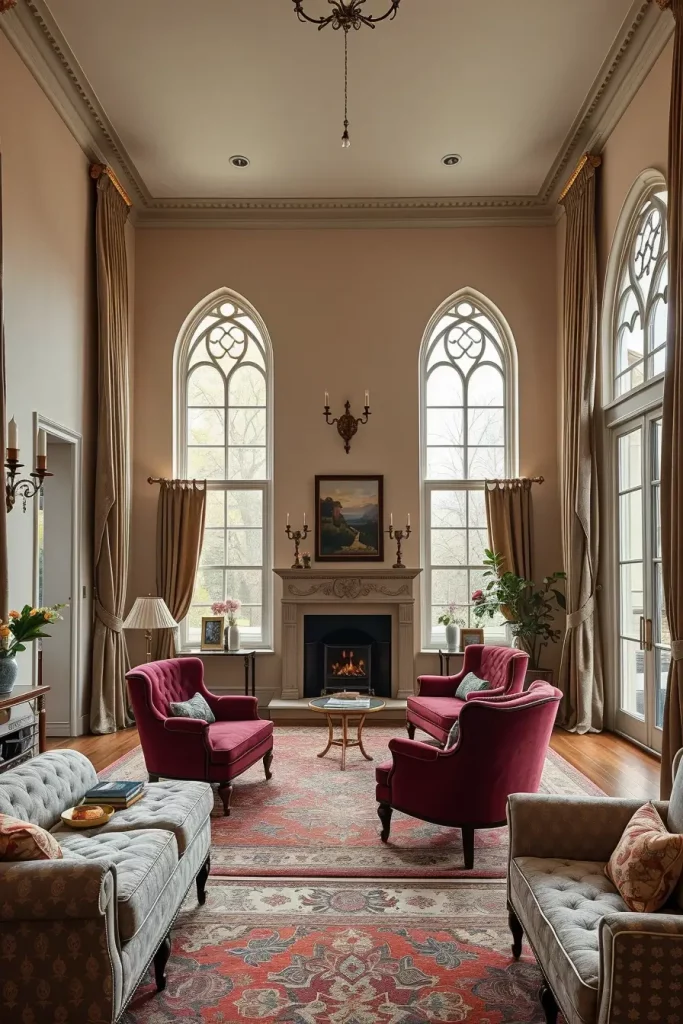
In my personal opinion, symmetry is what prevents a gothic living room to look disorganized. House & Garden usually emphasizes the importance of repetition in design, as it says that balance brings peace. I adhere to this principle when I work with paired windows, so that the furniture does not compete with the architecture, but supports it.
Something I would add here would be the subtle wall sconces that would be hung on each side of the windows, bringing warmth and accentuating the symmetry at night.
Oversized Arches That Define A Room’s Character
Oversized gothic arches may characterize the whole image of a living room. I have also observed how they behave almost like architectural sculptures, attracting instant attention and creating the identity of a room. Their size alone makes the space magnificent in a way that is difficult to achieve with any other design feature.
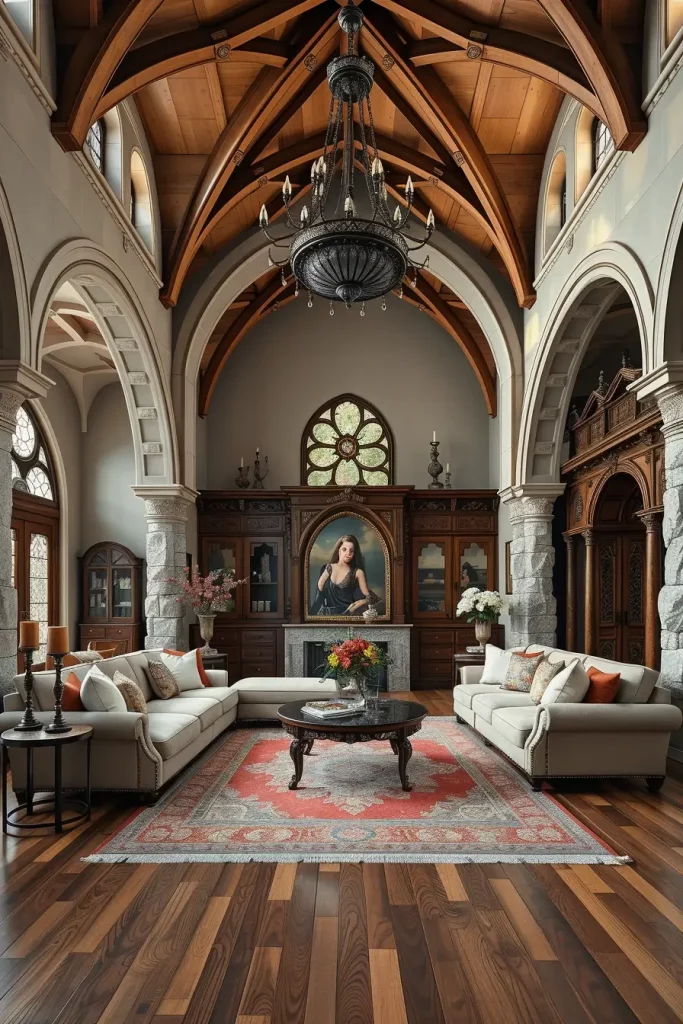
To balance over-sized arches I tend to use equally oversized furniture. Oversized coffee tables, large sectionals and dramatic lighting fixtures like wrought-iron chandeliers help to balance out the proportions. Otherwise, the arches will easily dominate smaller furniture.
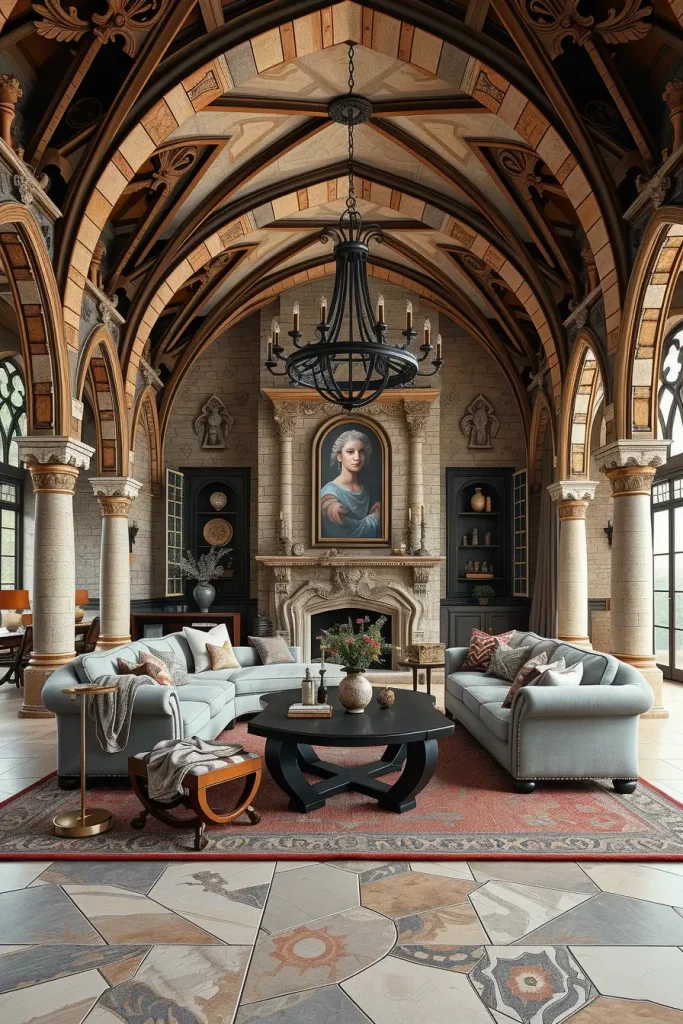
To my mind, oversized arches are most effective in open-plan living areas. I have seen in Architectural Digest, where these arches have been used to separate the living area and a dining space, and I have thought it was brilliant- it allowed openness but gave a subtle division of the room.
To conclude this part, I would suggest the use of layered textures, i.e. stone accent walls or carved wood panels, to emphasize the scale of the arches.
Layering Drapes On Gothic Windows For Depth
One of my favorite tricks with gothic windows is layering drapes. I think it gives the design depth and richness and also flexibility in light and privacy control. The drapes can be used to complement the shape of the window, not to cover it up when they are layered correctly.
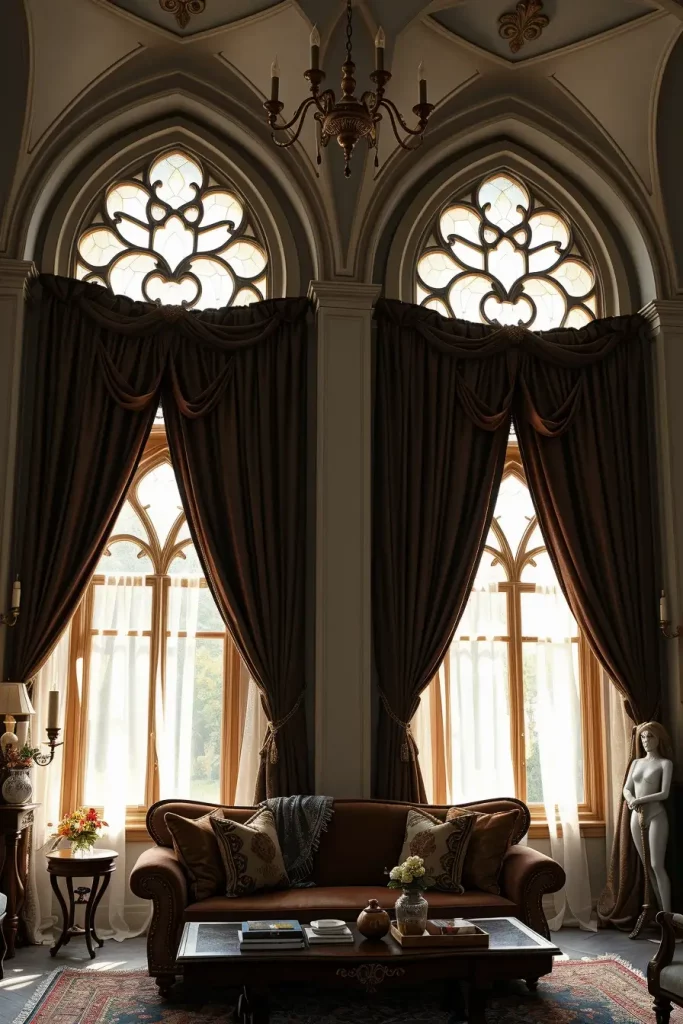
In this effect, I generally begin with light gauzy curtains that diffuse the light gently, and then add heavy velvet or brocade draperies over them. Fancy curtain rods with finials made of iron or brass also help to frame the windows in a beautiful way. The gothic living room can really use this layered texture to soften the harsh lines of the building.
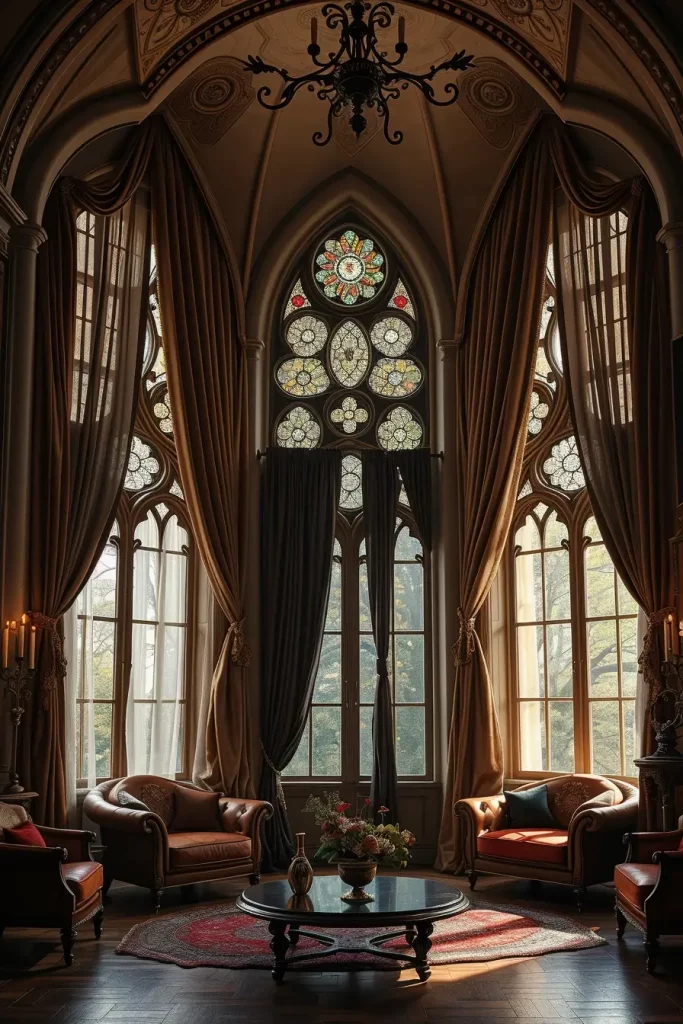
I think this design trick is very successful in both conventional and contemporary gothic interiors. A previous issue of Elle Decor pointed out the importance of layered window treatments to create depth in a room, and I have done this many times to great effect.
I would also include a dramatic tieback, possibly braided cords with tassels, to help keep the drapes pulled back neatly and help add to the gothic style.
Combining Arches With Vaulted Ceilings
When I use gothic arches with vaulted ceilings, I get a feel that is almost cathedral-like. This combination enhances the feeling of height and space in the living room and makes it look more open and grand. The arches and the lines of the ceiling lead the eye upwards in a harmonious, dramatic way.
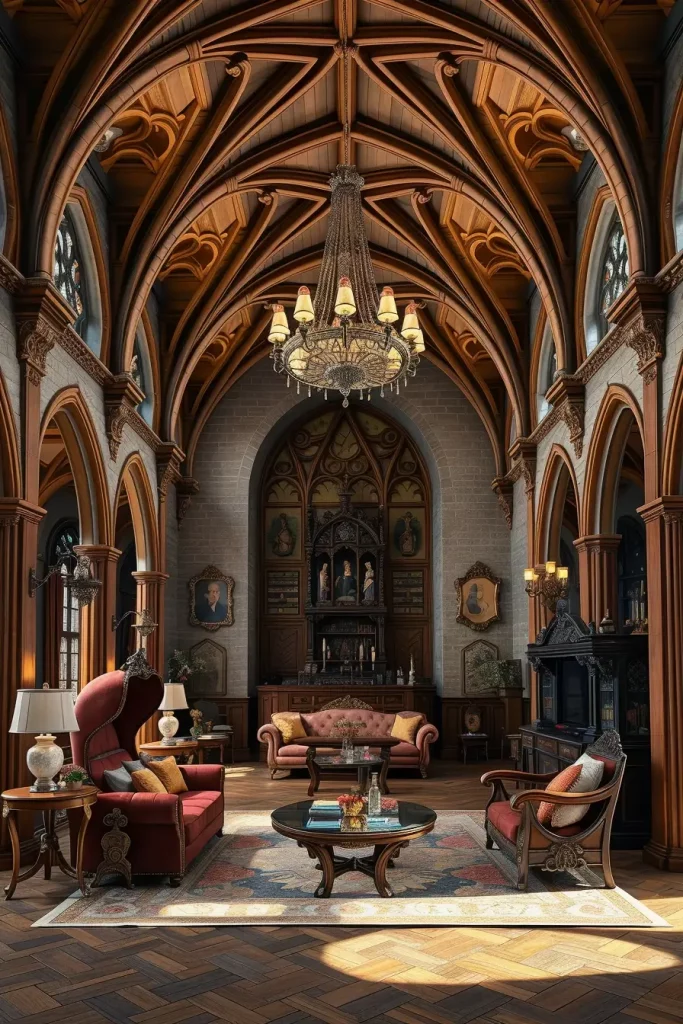
The style around this I would suggest is bold chandeliers that will highlight the vertical space. Gothic-style furniture like carved wooden chairs, high-back sofas, and ornate tables add to the pomp but maintain the proportions in balance.
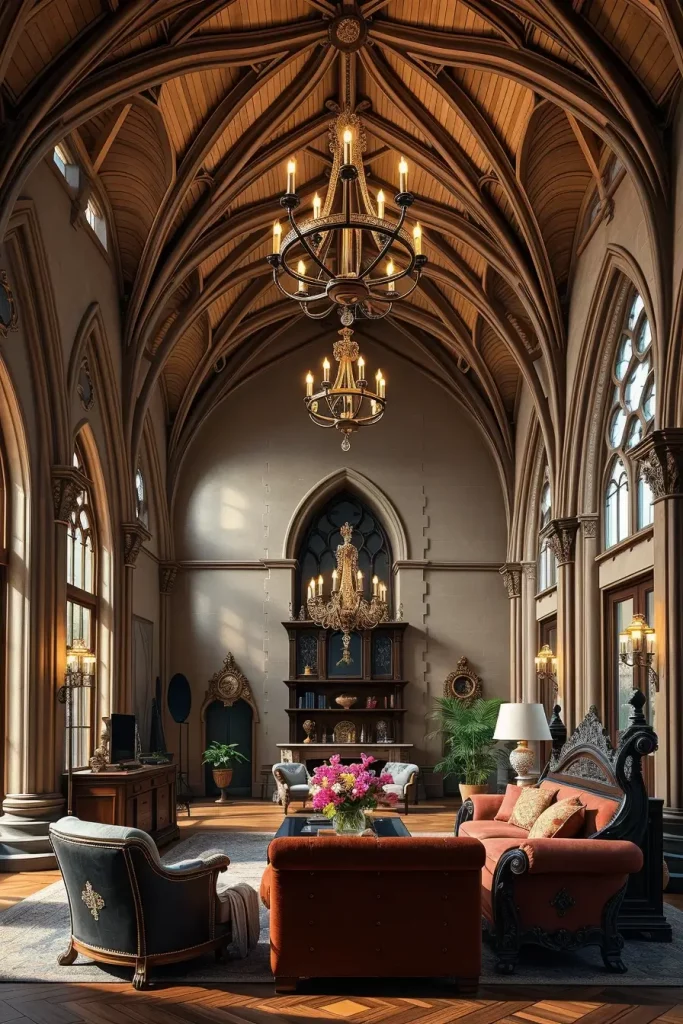
In my opinion, vaulted ceilings are the chance to emphasize details. I have read in Veranda that beams or ribbing in vaulted ceilings add to their gothic character, and I think so. I have applied this method to give a more realistic effect in a living room design.
The only thing I would add here is ambient light on the beams or the edges of the ceiling. This makes the dramatic structure visible at night.
Dark Frames That Accentuate Gothic Windows
Dark window frames have always seemed to me as the ideal way to bring out gothic designs. Frames are black or dark bronze, which accentuates the shape of the window, making the architecture more visible and prominent. In a living room, this effect makes windows a statement piece even when it is not the biggest element of the room.
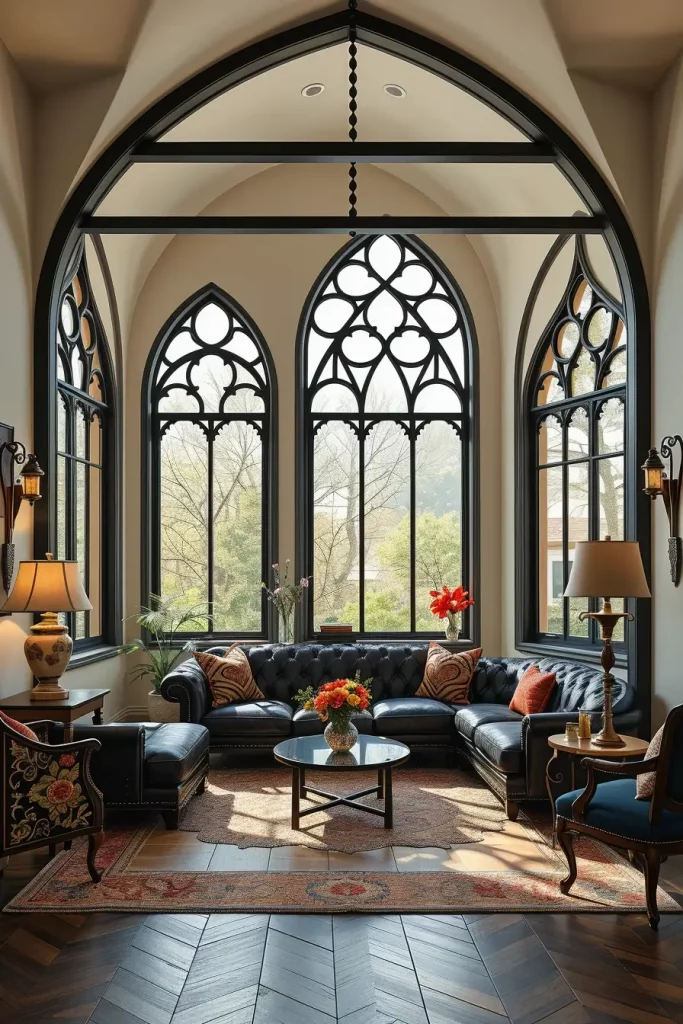
To balance dark frames, I usually add furniture of similar color. A black coffee table, wrought-iron side lamps, or a dark leather sofa can pull the look together without overpowering the room. The contrasting of them with lighter wall colors can produce an eye-catching effect.
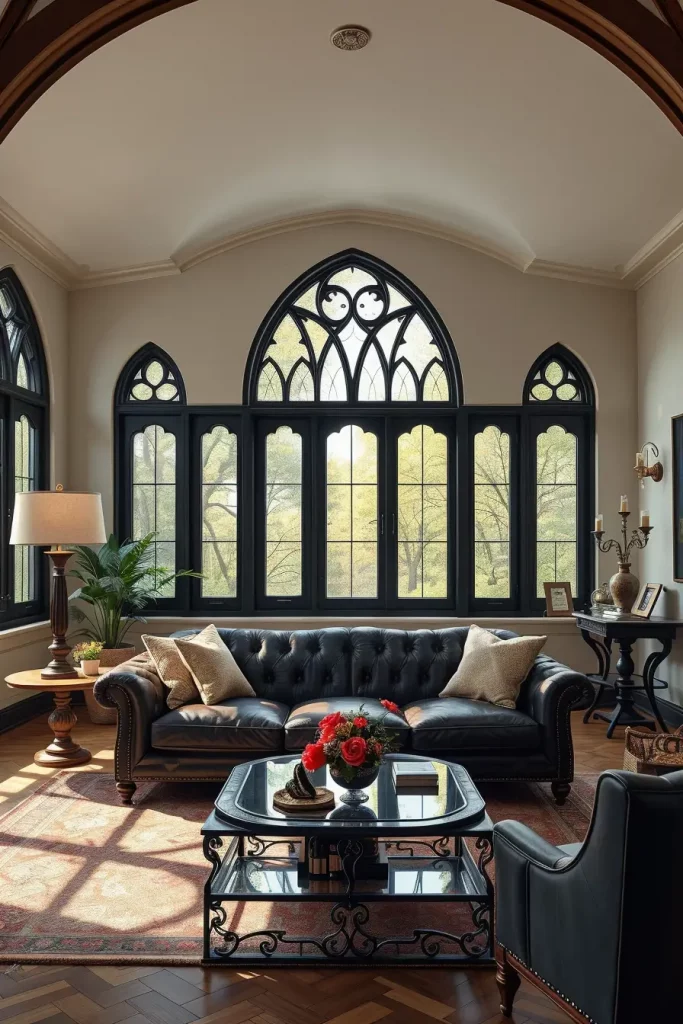
I think that dark frames are particularly convenient in contemporary interiors. They introduce gothic drama without necessitating a lot of architectural modifications I have also seen this technique featured in Dwell, where simple arched windows were made into gothic masterpieces by sleek black frames.
To finish this section, I would recommend including textured rugs or upholstery in jewel tones- emerald, ruby, or sapphire, which will provide balance and richness to the frames.
Using Leaded Glass For Authentic Detailing
One of the most genuine details that you can add to a gothic living room is leaded glass. I find that the geometric patterns not only provide an extra level of complexity but also allow dispersing natural light in a more atmospheric manner. This description immediately gives the space a more historical grounding.
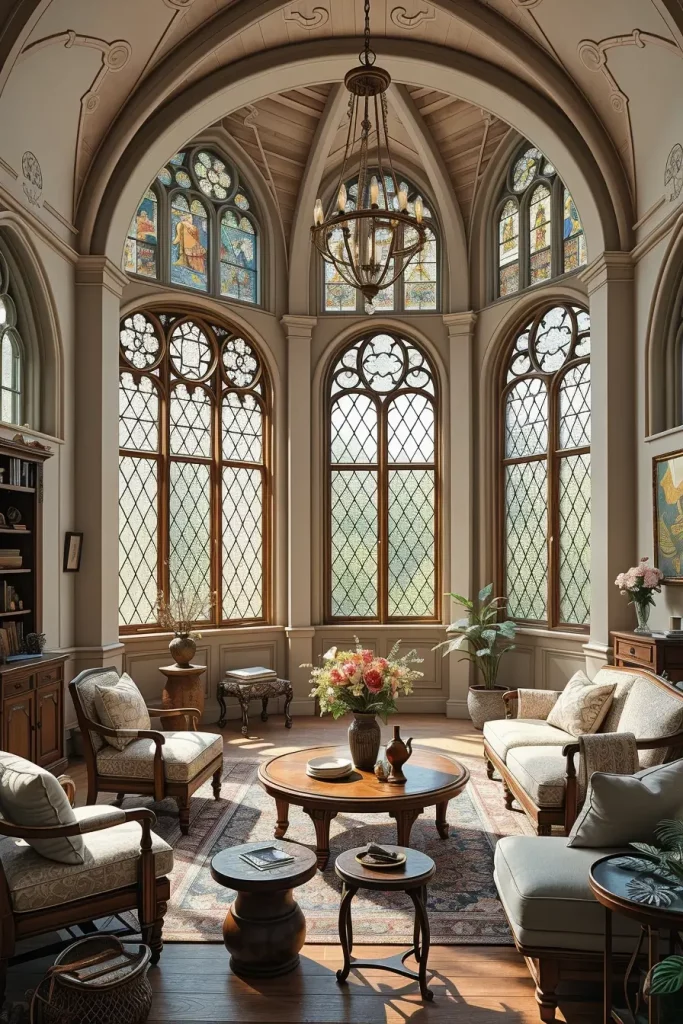
I prefer to have the other furnishings simple when leaded glass is used. The glass is the star, with simple wooden furniture, understated fabrics and gothic-inspired lighting. Too much clutter can easily dwarf the craftsmanship.
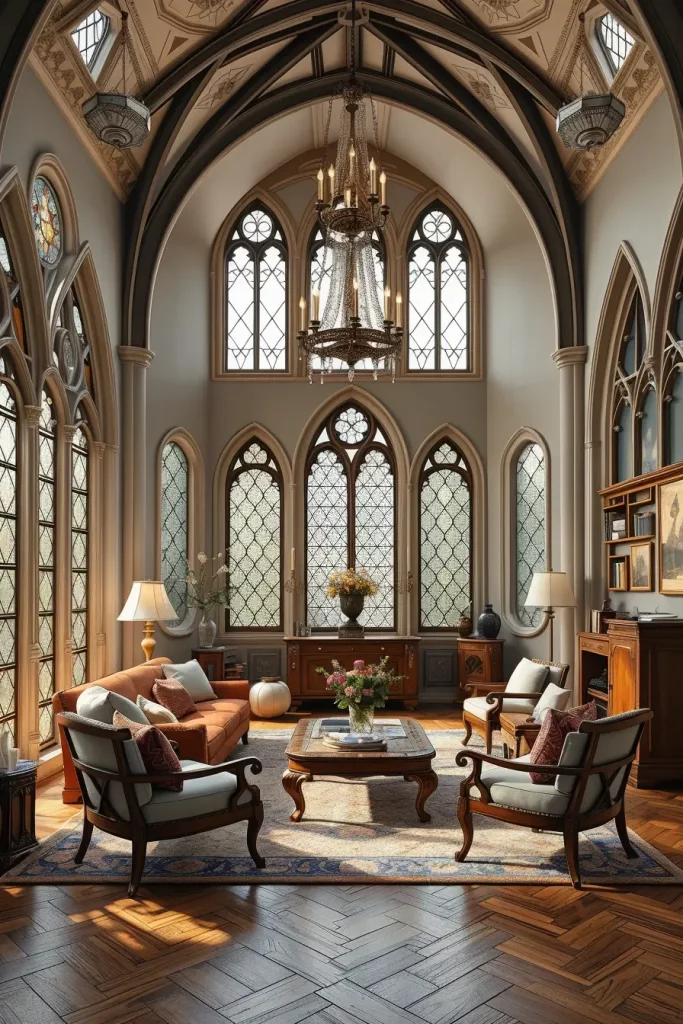
In my own opinion, leaded glass gives it an invaluable touch of authenticity. House Beautiful once said that windows with detailing add more depth to a room than plain glass windows, and I strongly concur.
To add to this, I would recommend custom made leaded glass inserts in contemporary houses. This enables the gothic appearance to merge with modern building.
Enhancing Natural Light Through Gothic Shapes
The ability to improve natural light is one of the greatest advantages of gothic windows. The long, sharp profiles enable the light to enter in dramatic angles and alter the ambiance of the living room as the day goes by. I have seen how this aspect can make even a darker interior feel lively.
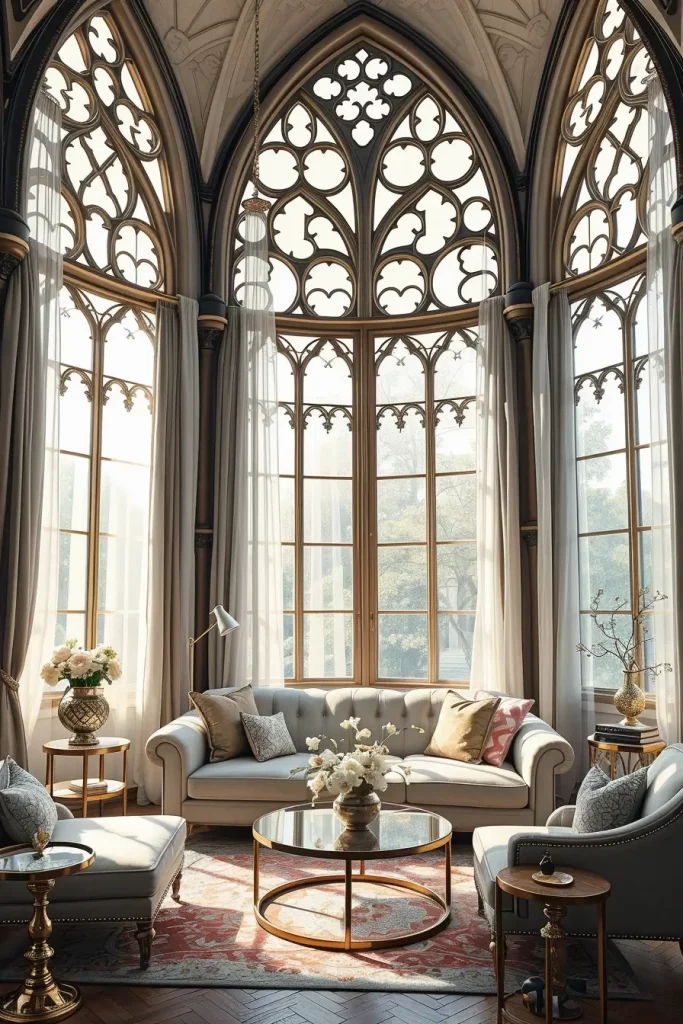
To reinforce this, I would suggest having window coverings to be minimal or sheer so that the natural light would be the main attraction. Furniture that can reflect light into the room can be used such as light colored sofas, reflective tables, or metallic decorations.
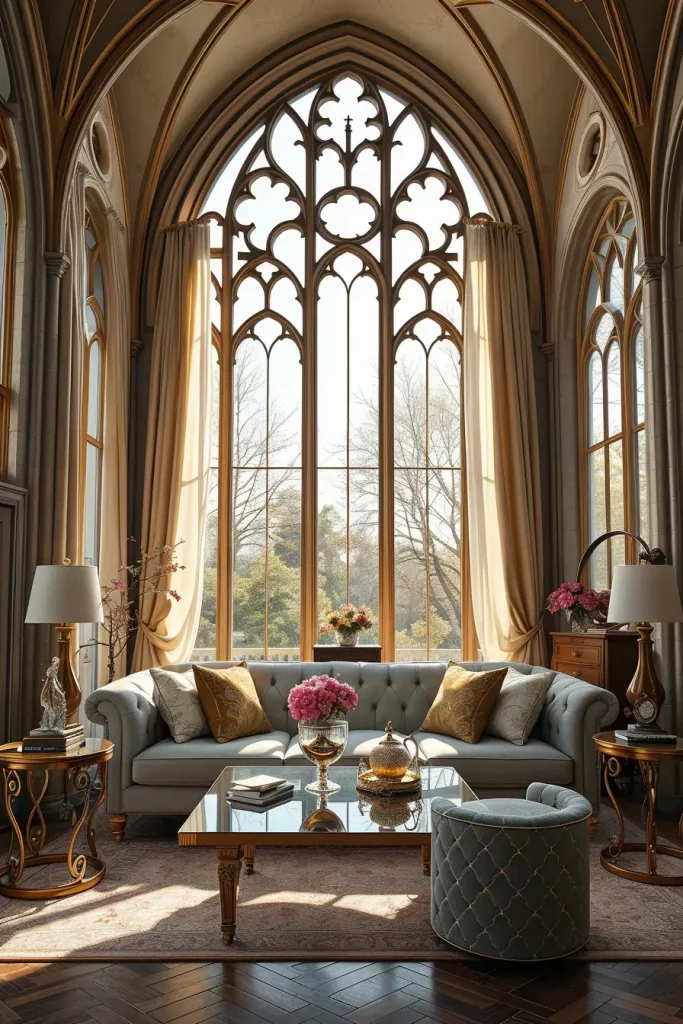
I personally believe that gothic shapes make light itself a part of the design. Architectural Digest once referred to gothic windows as light sculptures, and I could not put it better. They make the atmosphere change with ease
I would also add mirrored decor or glossy surfaces that would reflect the natural light further into the space and make it more effective.
Window Seats Within Gothic Arched Niches
I think one of the most practical applications of gothic arches is to make use of the deep niches in them to incorporate window seats. The high arch provides a natural frame to the seat, giving a sense of privacy but in the context of the living room. This kind of design does not only provide more seating but also utilizes natural light, making it a comfortable place to read or to sit and reflect.
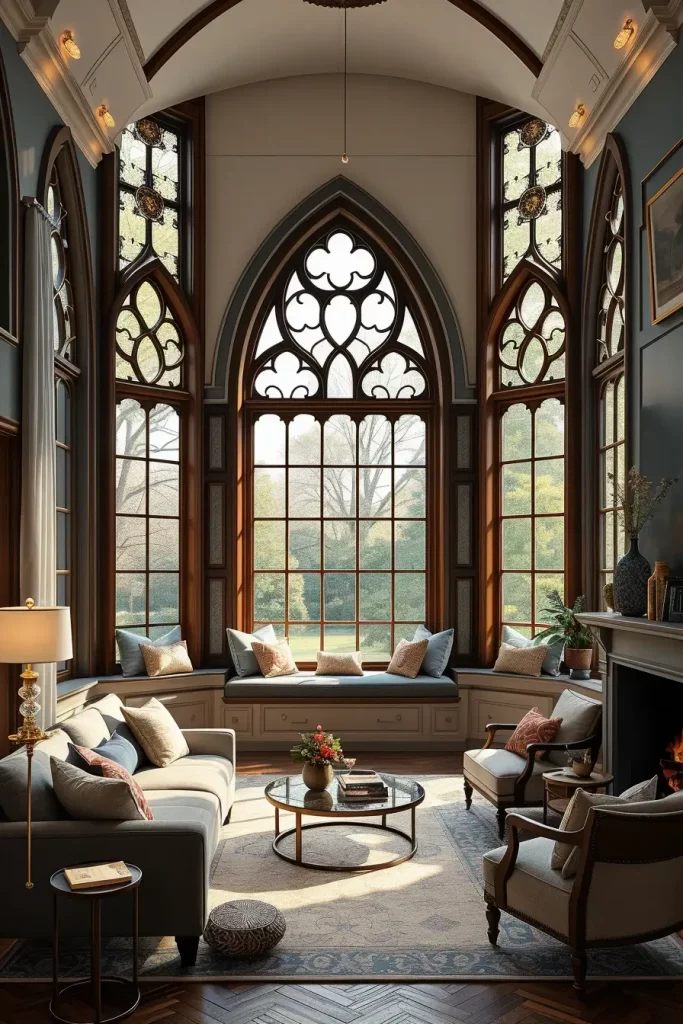
When I plan around such window seats, I tend to use luxurious cushions, beautiful fabrics and storage space under the sitting. The gothic nature is emphasized by wooden frames or carved stone parts, and the comfort is provided by layered fabrics. The furniture should not feel out of place, and thus I do not use bulky furniture that may interrupt the flow of the niche.
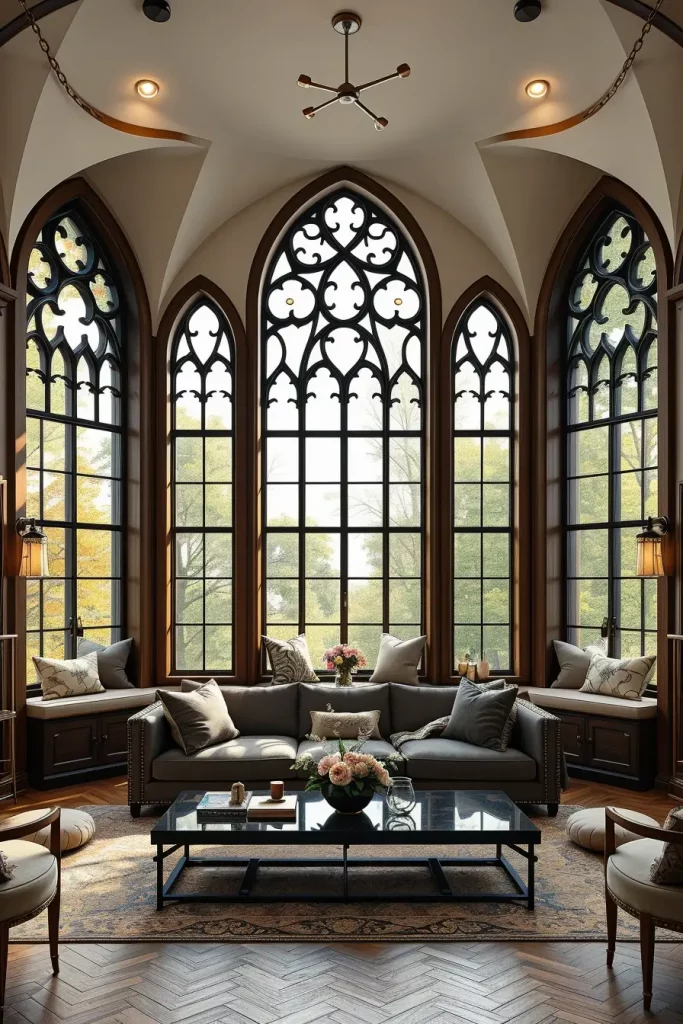
This is, in my opinion, one of the best options of a gothic-style room. Architectural Digest reports that built-in window seating is back in the modern home due to both its functionality and design. Combining that tendency with gothic arches makes the concept both classic and contemporary.
The one thing I would do here is add more layered lighting, like sconces or small lamps, to allow the window seat to be used at night without overwhelming the intimate atmosphere.
The Romantic Feel Of Curved Stone Arches
A gothic living room has a romantic feel with the use of curved stone arches. The curvy line mellows the verticality of the room and instantly conveys power and stability. The carved stonework gives the space a sense of history and artistry that makes the space feel elevated and purposeful to me.
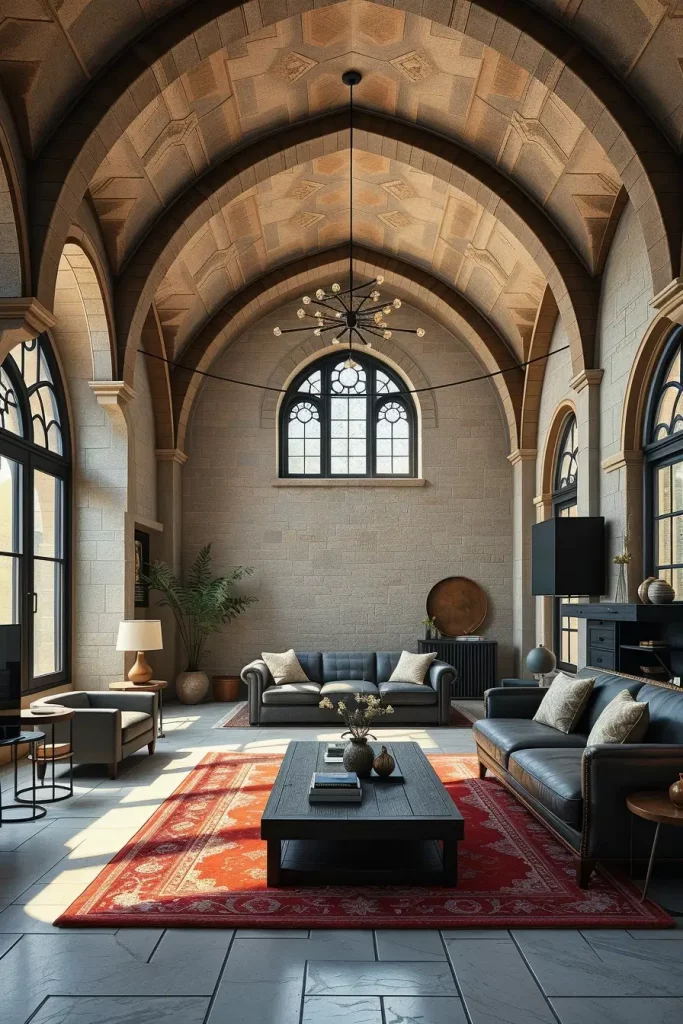
I like to counterbalance these arches with minimal furniture around so that the stonework is apparent. A smooth couch, a coffee table with wrought-iron decor, and plush carpets make good additions. When I select darker woods or leather, they do not overwhelm the stone but reflect the seriousness of the stone.
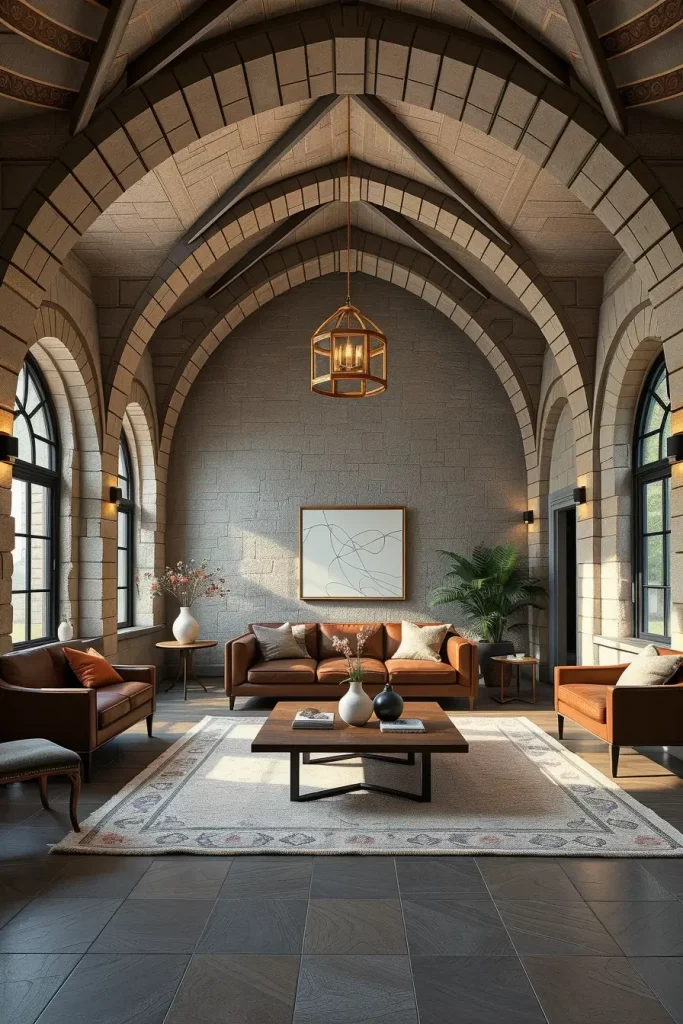
I have found that people tend to think of stone arches as being something that belongs in a castle, but they work equally well in contemporary interiors. Experts at Elle Decor tend to emphasize the utilization of natural materials such as stone to generate focal points that bridge the past and present lifestyle. I concur with this practice.
I would recommend the implementation of subtle wall lighting that accentuates the texture of the stone so that the arches can be seen in the evening hours.
Fireplace And Window Pairings In Gothic Style
A fireplace and gothic windows make a dramatic focal point. The juxtaposition of warmth and light is what makes the combination so compelling to me because it brings together two traditional areas of focus. They are combined to form symmetry that improves the mood of the living room.
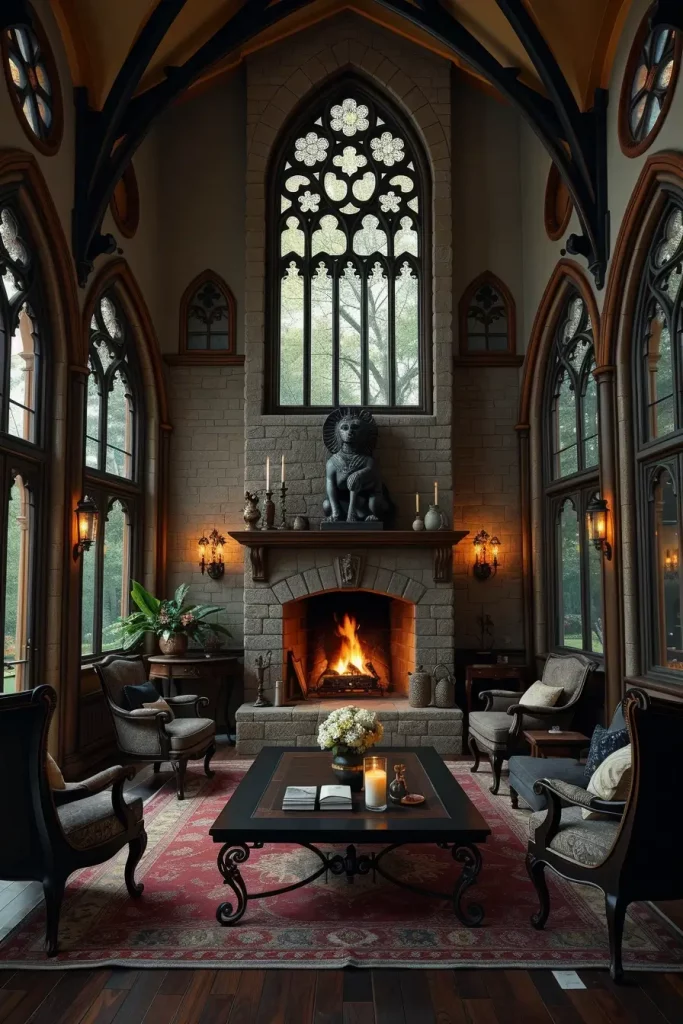
When I design these combinations I tend to have tall arched windows on each side of the fireplace. The fireplace can be of stone or dark wood, with carved details that resemble the arches above. Additional furniture consists of armchairs with high backs, low coffee tables and iron furniture like candleholders.
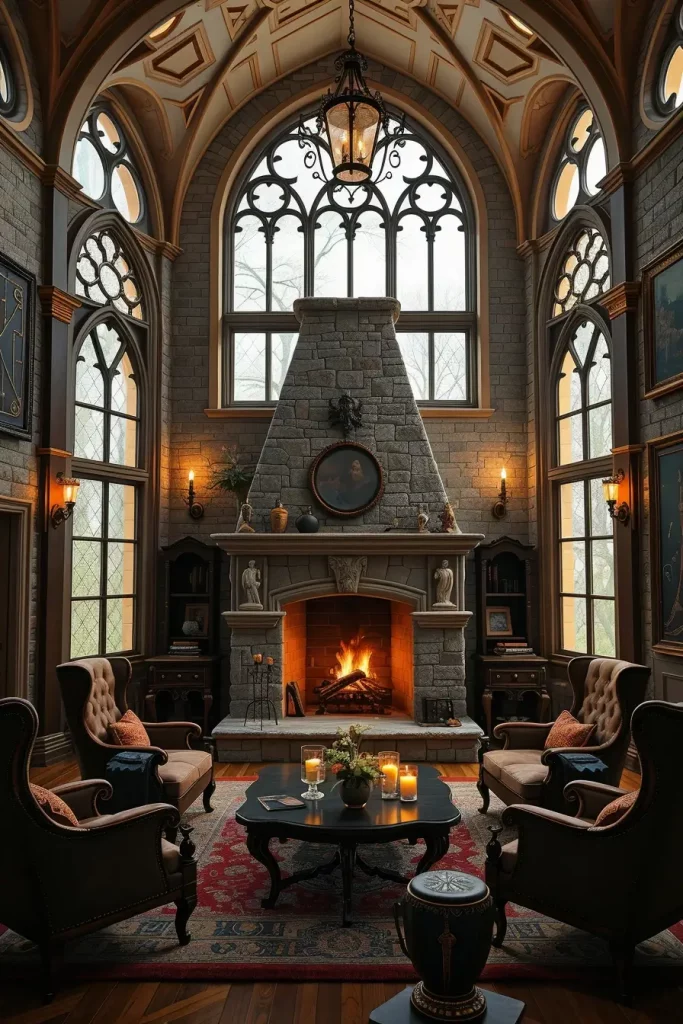
I think that this combination is most effective when it is balanced. The room can be overpowered by excessive ornament. Architectural Digest frequently recommends that large elements should be simple and that the design should be in the form. I use this rule in working with fireplaces and gothic windows.
One of the improvements would be to have stained or frosted glass in the windows so as to reflect the firelight and make the place still more atmospheric.
Adding Chandeliers To Highlight Arched Windows
Chandeliers are also necessary in accentuating tall gothic windows They attract the gaze upwards and stress the verticality of arches. I find them both practical and ornamental, and a balance between the weight of arches and the lightness of light.
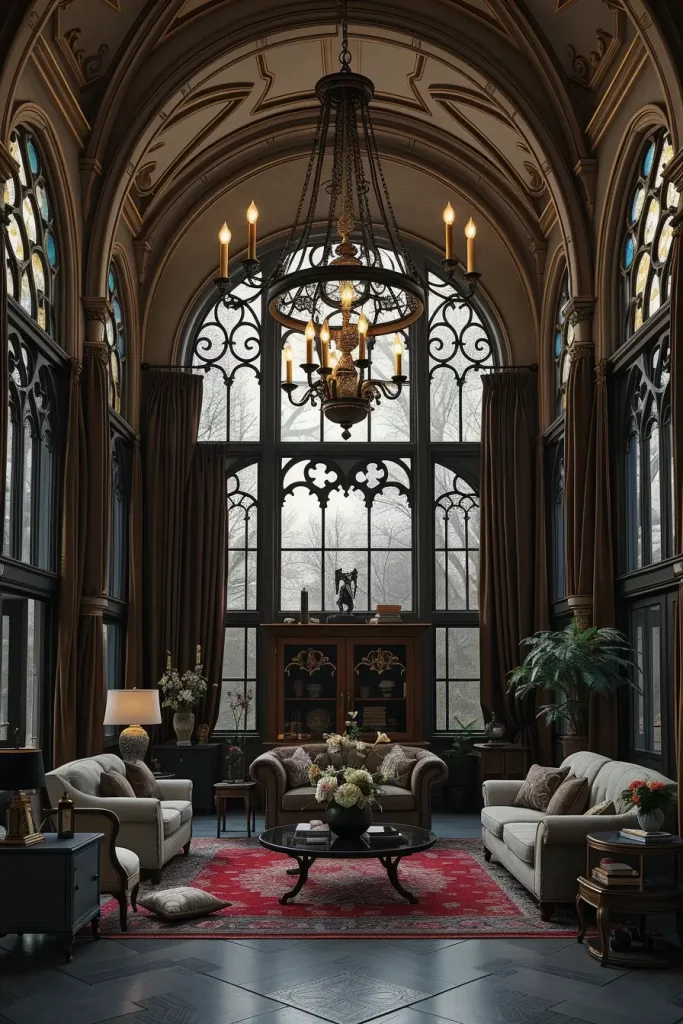
I tend to suggest wrought-iron chandeliers using candle-type bulbs. They are gothic in design but practical in the contemporary households. The light combined with tall drapes or layered curtains will provide depth and warmth to the room.
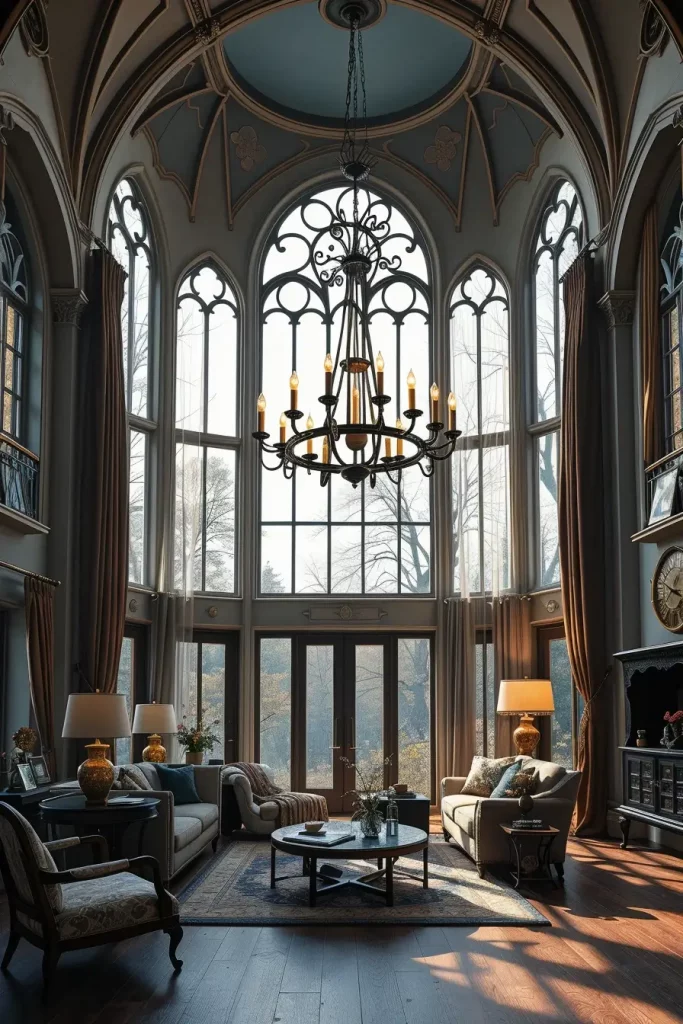
In my professional view, chandeliers should be a bit in front of the windows and not directly in front. This enables the light to trickle down the arches without obstructing the view. House Beautiful says that layered lighting is essential to dramatic interiors, and it is true here.
I would recommend the use of dimmers on the chandelier so as to have flexibility in setting the mood depending on the time of the day or occasion.
Incorporating Ironwork In Gothic Window Design
Gothic windows are made more beautiful by decorative ironwork. Iron tracery, mullions, and grills have been used in my experience to not only make the window stronger, but also to add interesting patterns that filter light in interesting ways.
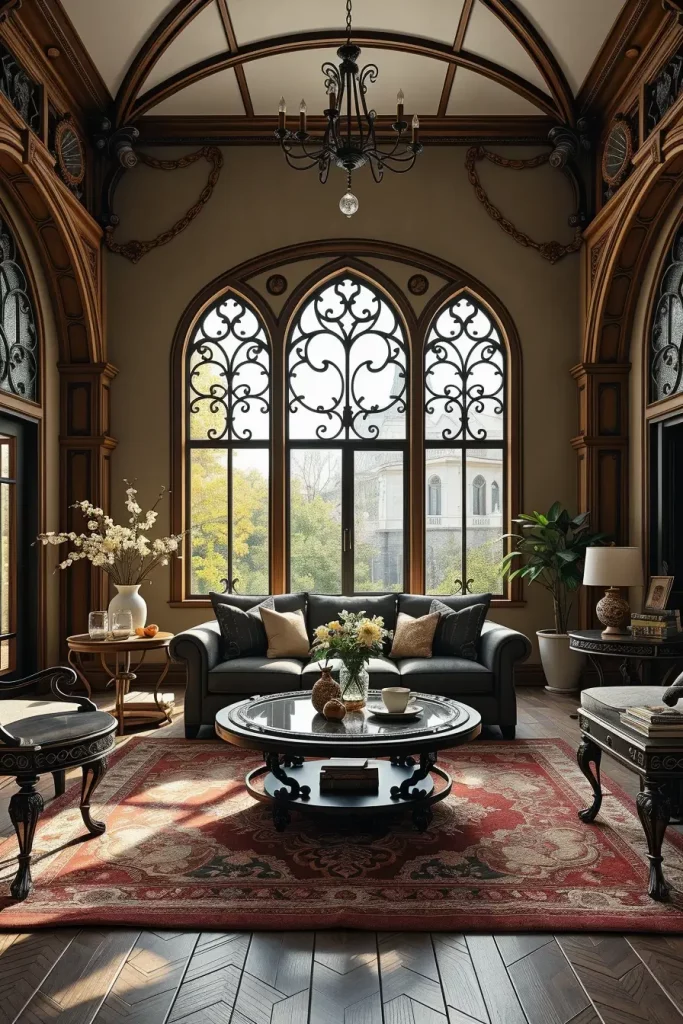
As far as furniture is concerned, I would also repeat the iron details in the form of coffee tables, side tables with metal legs, or even iron curtain rods. These decisions form unity and make the design purposeful.
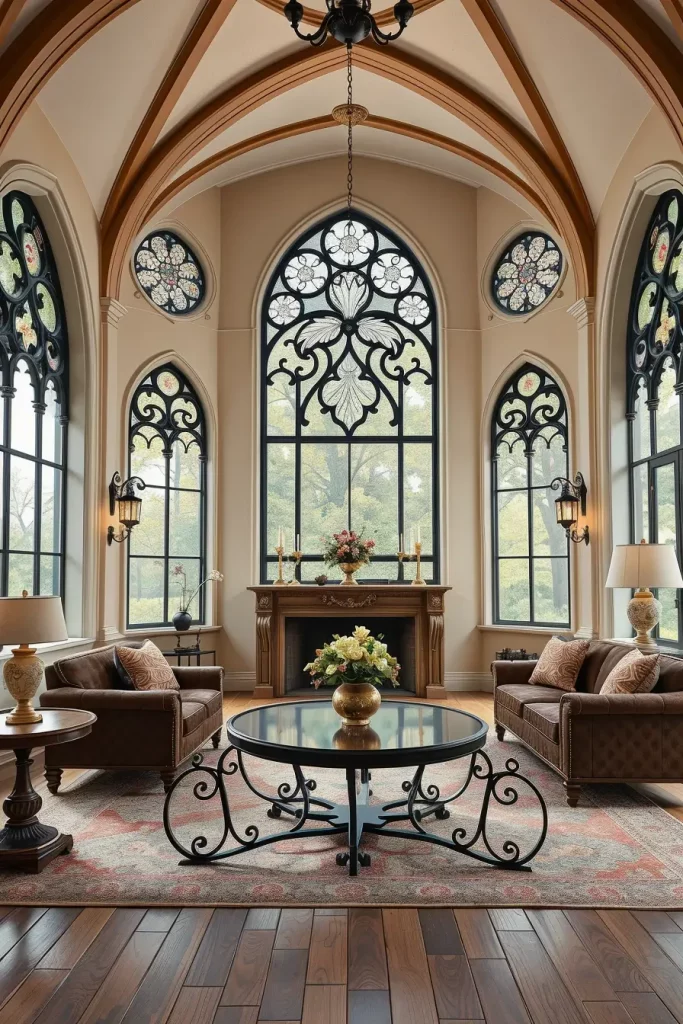
In my view, ironwork is durable and yet ornamental. Most designers based in the US stress on the significance of repeating patterns in a room and I apply the same principle to the use of ironwork in various elements.
One thing that could be done here to improve it is to add some gold or bronze accents to the iron, which will mellow out the darkness without losing authenticity.
Custom Furniture To Match Gothic Arches
Gothic arches are reflected in custom furniture to create a powerful design language in the room. In my designs, I tend to create shelving units or cabinets that have pointed arch tops to give them a visual reference to the windows and doorways. This brings about continuity and reinforces the identity of the room.
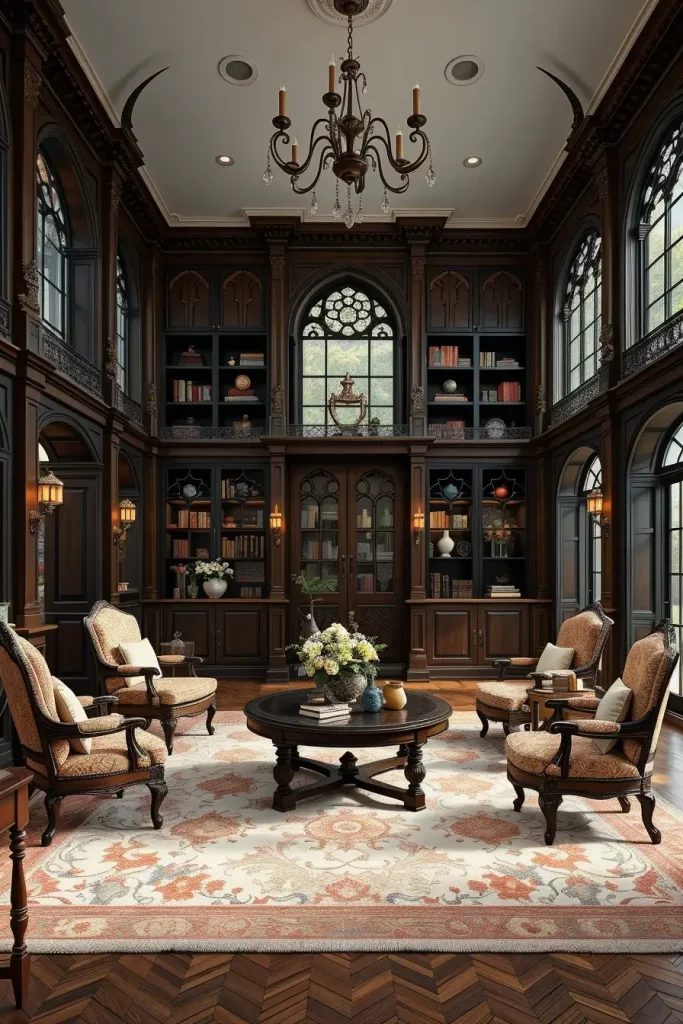
For furniture pieces, I prefer dark wood bookcases, carved headboards (if in a sitting room with daybeds), and accent chairs with arched backs. These items are coherent and fulfil practical purposes.
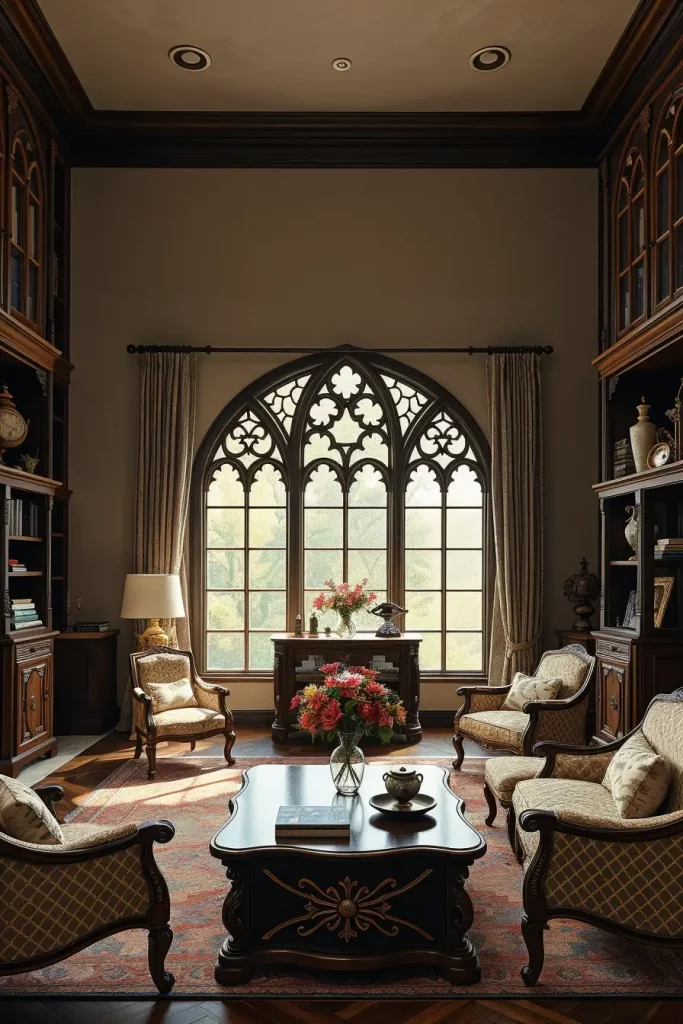
I feel that custom furniture is worth the money in these rooms. As Elle Decor has implied, customized furniture tends to enhance a room by making it distinctive. I use that philosophy in designing around gothic living rooms.
Other items that I would add would include textiles in the form of rugs or upholstery with repeating gothic patterns to connect the custom furniture with the rest of the space.
Layered Textures To Complement Gothic Openings
When dealing with gothic openings, texture is a must. The architectural size of arches and windows requires counterbalance with more layered materials. I personally soften the otherwise hard geometry with textured walls, velvet fabrics and heavy drapery.
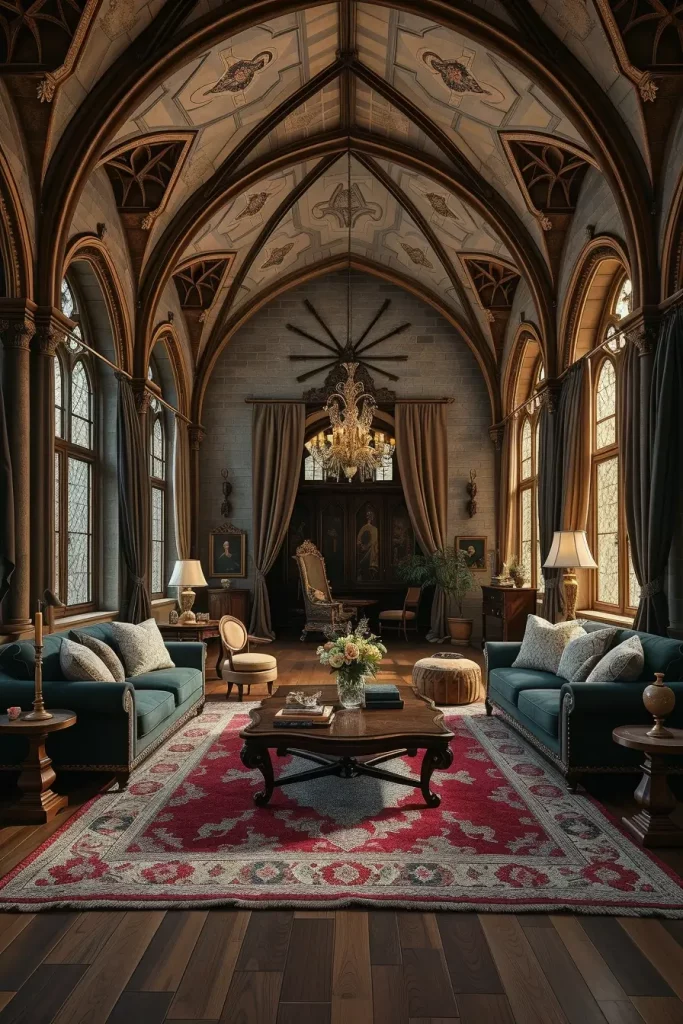
Furniture also has a significant role to play as well The leather sofas, wool rugs and carved wooden side tables provide tactile richness. All these objects prevent the room feeling cold and make it comfortable to live in without violating the gothic atmosphere.
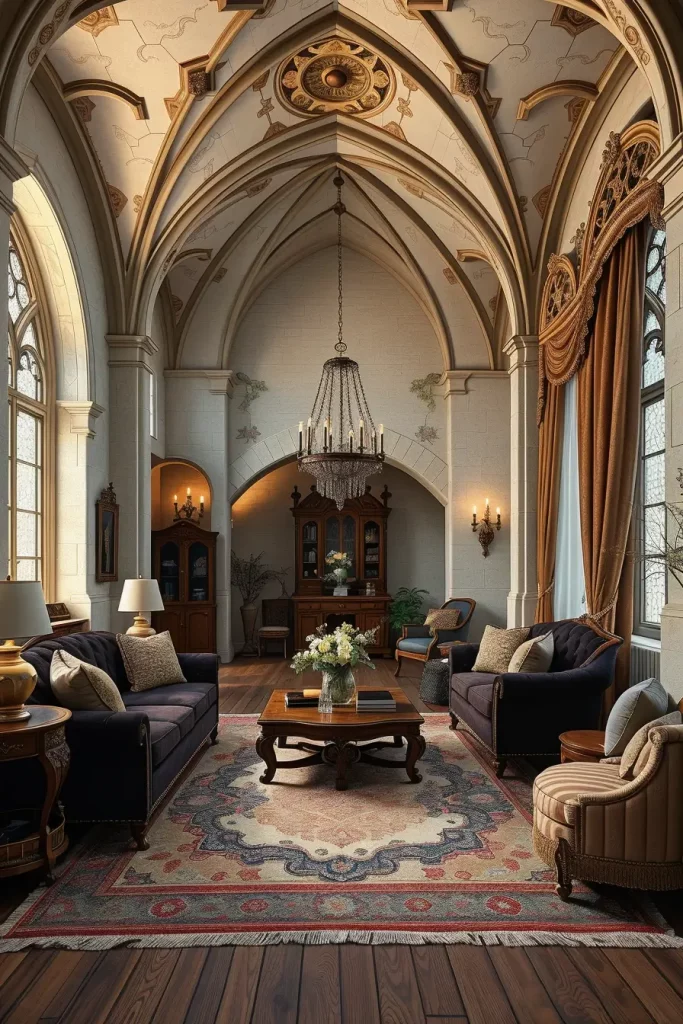
Texture, in my opinion, makes it warmer and more accessible. In its absence, gothic interiors run the risk of being too stark or too museum-like. The recommendation of well-established designers to layer the textures to counterbalance architectural formality is very useful in practice.
Another aspect I would include is wall hangings or framed art that would include textile or relief work to further the layered effect.
Color Palettes That Enhance Gothic Living Rooms
The color scheme is one of the most characteristic elements of gothic living room design when I think of it. Dark, rich colors such as burgundy, forest green and midnight blue are usually at the center of the scheme. These tints produce an intimate and dramatic effect, as well as emphasize the architectural elements of arches and windows.
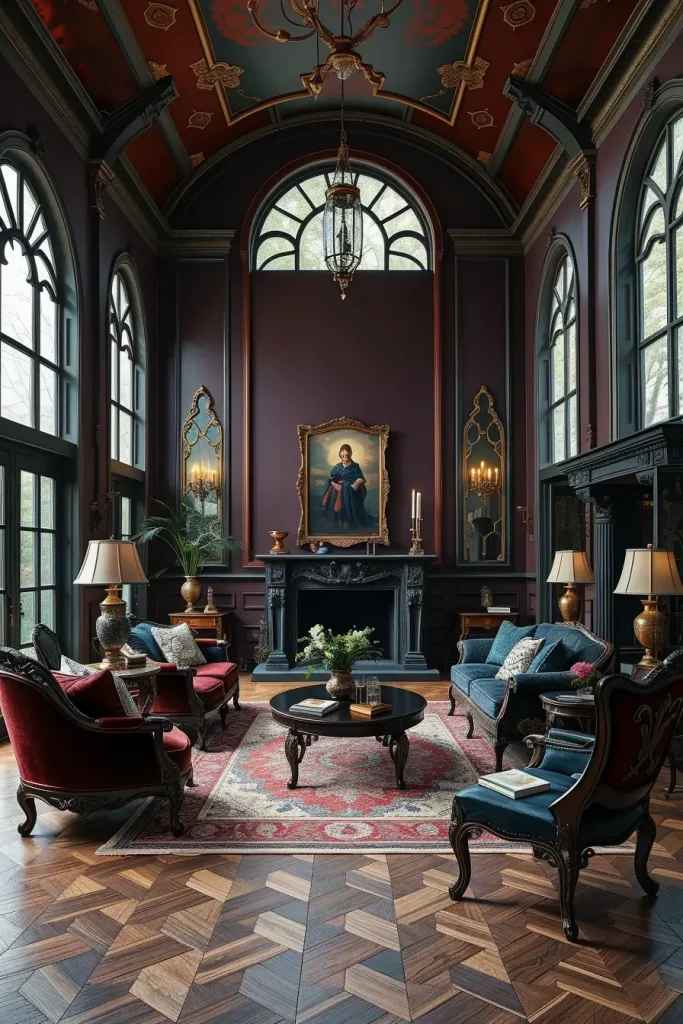
As far as furniture is concerned, I prefer dark wood furniture with heavy carvings that can contrast with the dark walls. The richness of the palette is supported by such accents as metallic candleholders, embroidered cushions, or velvet upholstery. It is all about striking the balance between being bold and being comfortable so that the space does not feel intimidating.
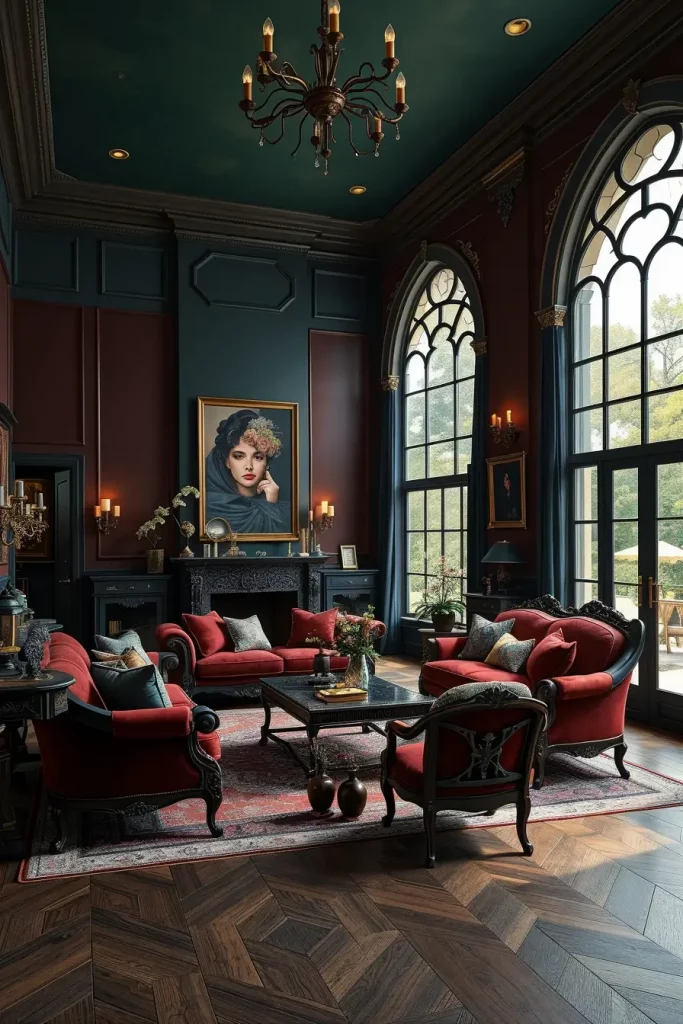
In my opinion, the gothic interiors are distinguished by using such deep colors. Designers at Elle Decor have reported that darker colors are returning to the contemporary home as they are timeless and luxurious. I am in complete agreement with this, particularly when gothic elements are involved.
I would introduce lighter secondary colors such as ivory or pale gray to avoid making the room too heavy, especially around the windows to allow the natural light to be noticed.
Curtains And Drapery Ideas For Tall Arches
Drapery and curtains are very important in gothic arched windows, both in functionality and design. I prefer to use heavy materials such as velvet or brocade to underline the magnificence of the arches, and sheer layers to make the atmosphere softer with filtered light.
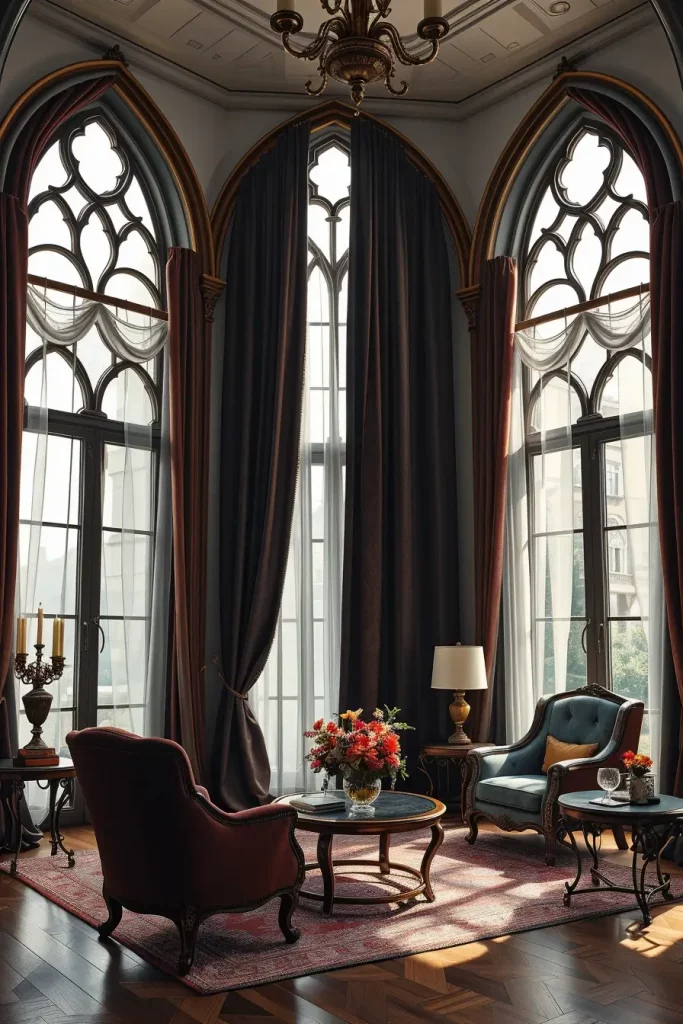
In my designs I generally suggest full-length curtains which fall well beyond the arch, and sometimes a little on the floor. The gothic theme is represented by rods and tiebacks in wrought iron or brass. Other furniture in the vicinity, including armchairs or small side tables, ought to be made of equally rich materials.
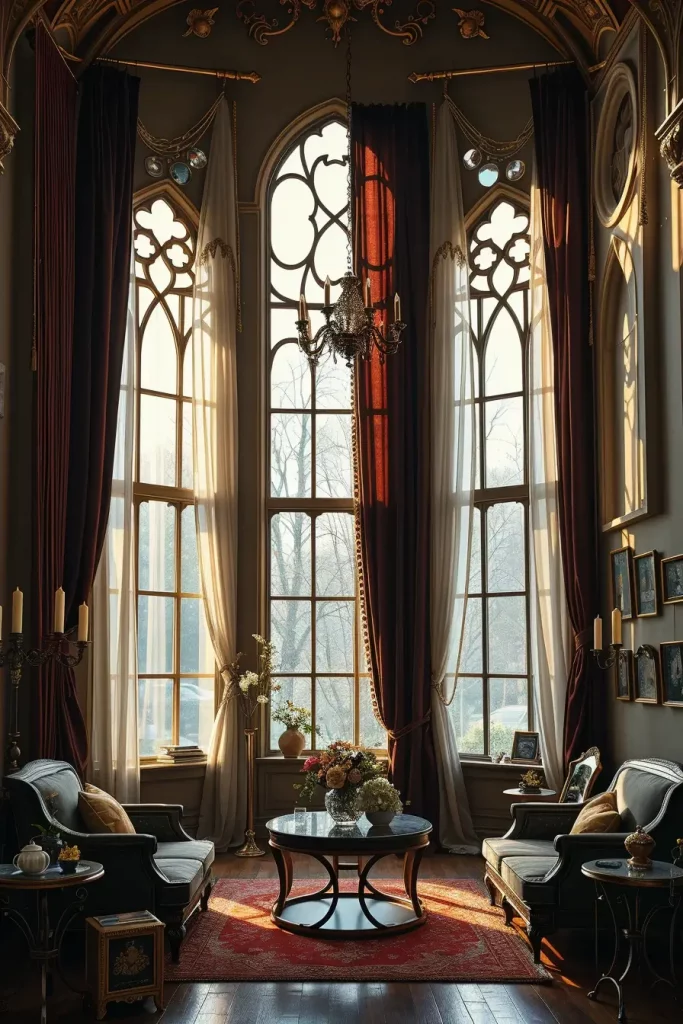
Personally, I find that drapery is what finishes the gothic living room. In House Beautiful, designers tend to emphasize layered curtains as a method of achieving the balance of light and privacy and maintaining a stylish interior. I have done this many times with great success.
And the one thing I would have added to it is dramatic tassels or embroidered edging, which adds to the luxury of the drapery without overwhelming the architecture.
Mirrors Echoing Gothic Window Shapes
I love to use mirrors that reflect the pointed arches of gothic windows in gothic living room design. They do not only reflect light but also visually enlarge the space and support the gothic appearance.
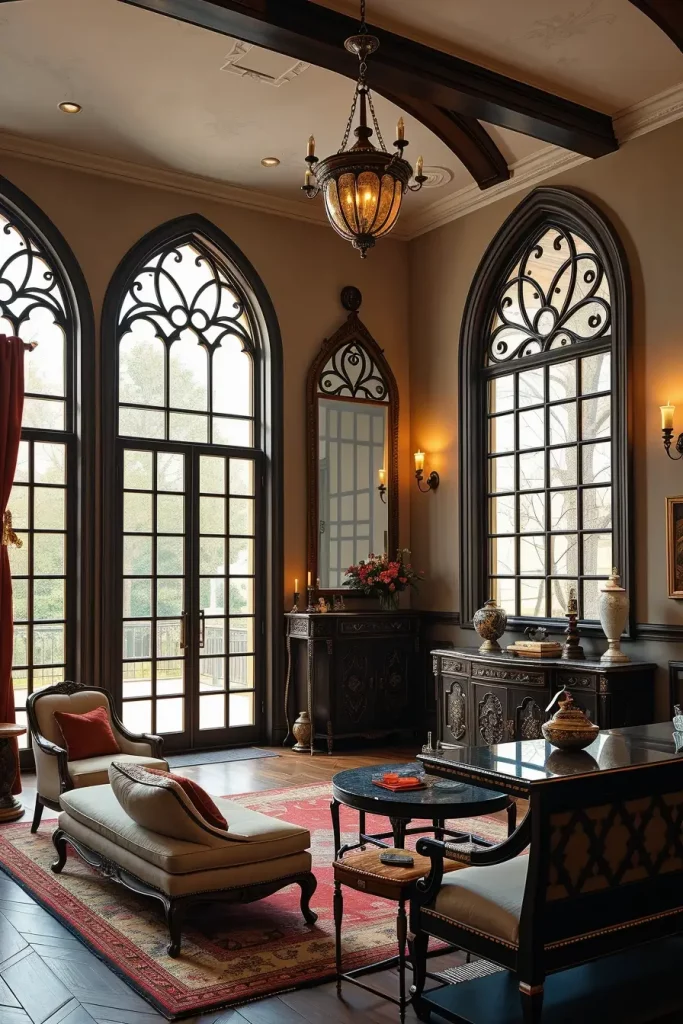
I prefer to put these mirrors on accent walls opposite real windows or fireplaces. Their frames, which are usually made of dark wood or wrought iron, repeat the architectural language of the room. Combined with basic pieces of furniture such as sideboards or consoles, the impression is elegant and harmonious.
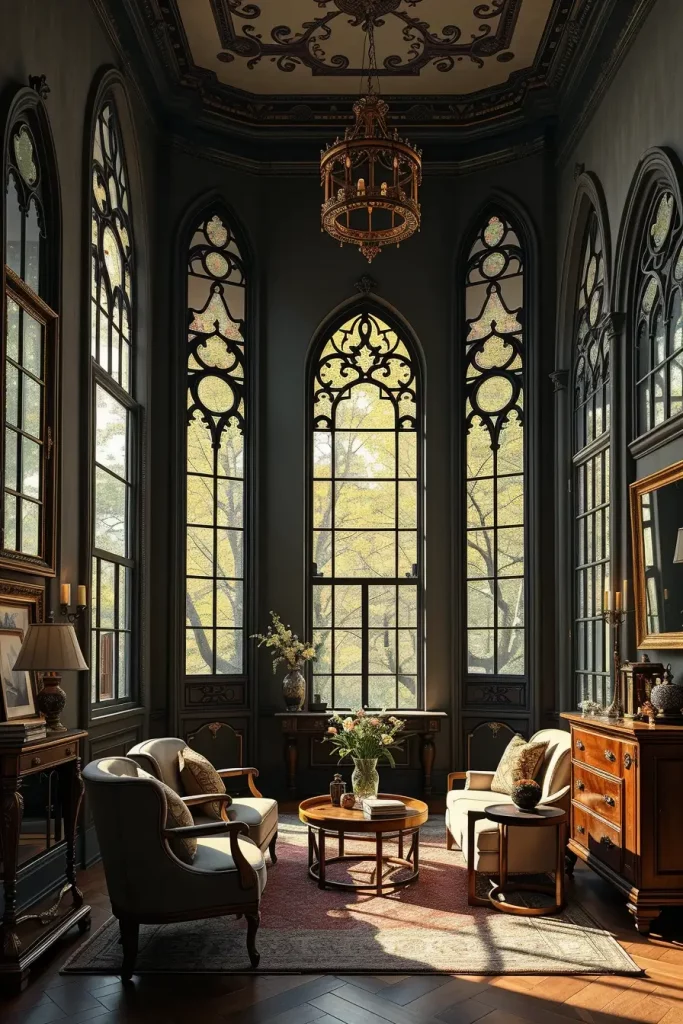
I think that mirrors are practical and metaphorical in gothic space. Architectural Digest says that mirrors have become a vital part of contemporary interiors to make spaces look bigger, and the gothic shapes make it special.
Another thing I would do here is to cluster smaller arched mirrors together to give the appearance of a gallery wall, which is particularly effective in smaller living rooms.
Blending Gothic Arches With Contemporary Furniture
A gothic living room does not have to be strictly historical, it can be easily combined with modern furniture. I believe that this combination is very effective since it does not make the room look like a museum.
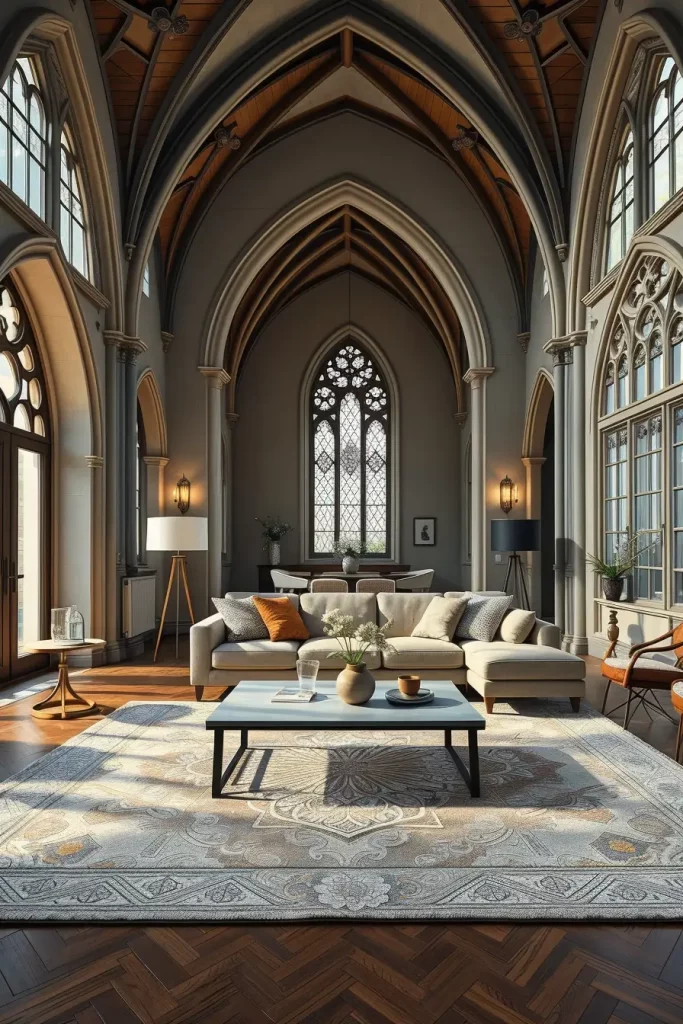
I also like to combine strong gothic arches with minimalist sofas, coffee tables, and contemporary lighting. These modern objects make the architecture stand out but the room is still habitable. Neutral upholstery and textured rugs will help in connecting the two styles.
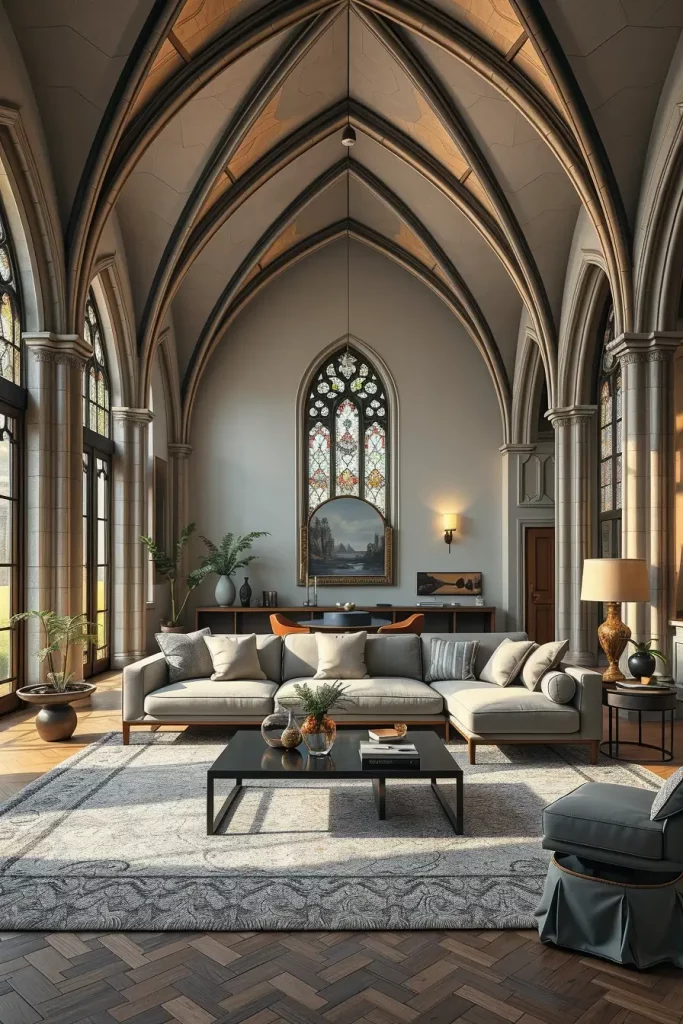
In my opinion, flexibility is shown through the mixing of styles. As Elle Decor often points out, the combination of traditional and modern is often the most interesting interiors. I have practiced this rule with much success.
The only other thing that I would recommend is the inclusion of a couple of statement pieces such as a contemporary sculpture that will contrast with the gothic building, yet enhance its drama.
Statement Walls Framing Gothic Windows
The statement walls are very effective in the gothic living rooms, particularly when they frame tall arched windows. I employ bold wallpaper, dark paint or textured paint to highlight the windows as focal points.
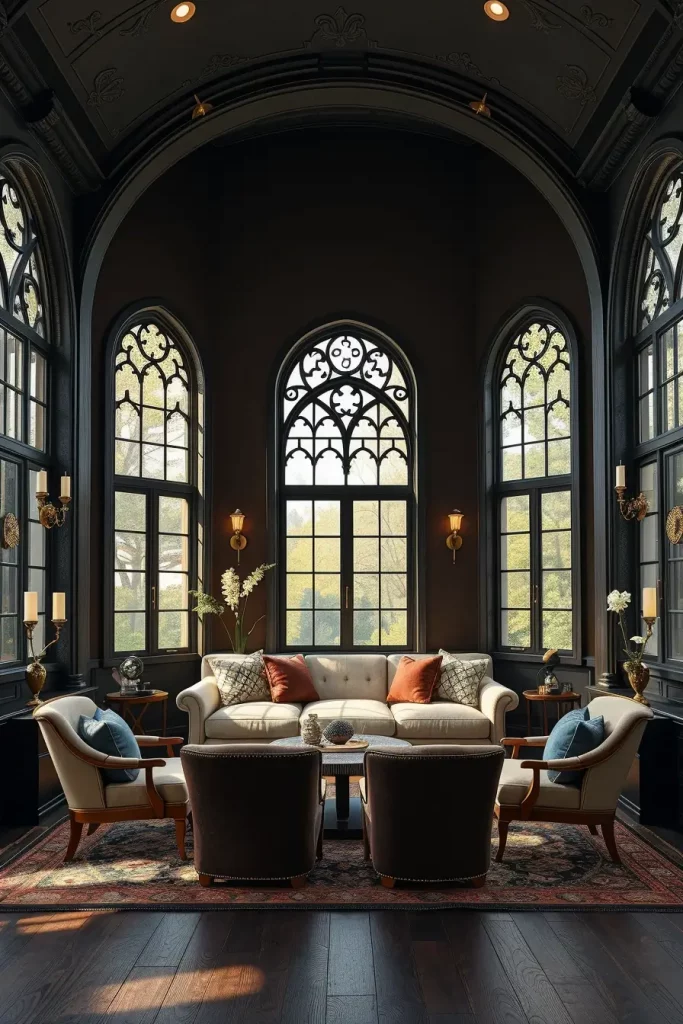
The arrangement of furniture is the most important here: a stylish sofa under the window, side chairs, or a console table will make it look anchored. Metallic accessories and wall sconces add to the wall without competing with the windows.
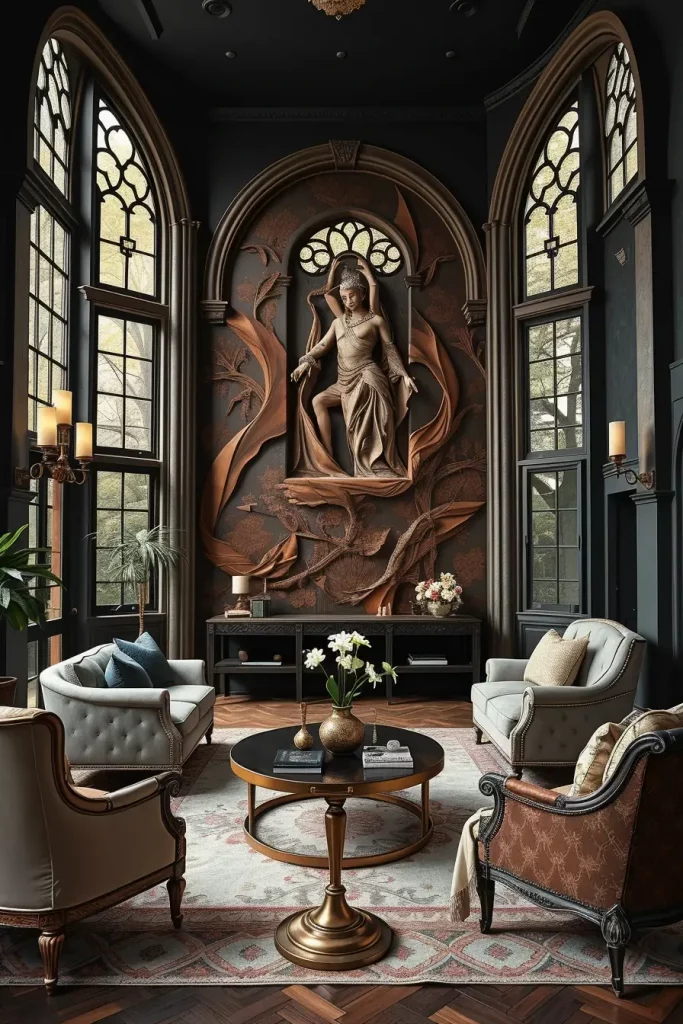
I think statement walls can completely change the room. House Beautiful cites the popularity of accent walls as the ability to be bold without being overwhelming to an entire room. I think gothic living rooms are ideal illustrations of this tactic.
I would add more to this by introducing some slight stenciling or patterns that would repeat gothic themes to further connect the wall to the windows.
Outdoor Views Framed By Gothic Arches
The most notable advantage of gothic arches is that they make outdoor views look like artworks. I adore how tall pointed windows frame landscapes, gardens or cityscapes and make them living murals inside the house.
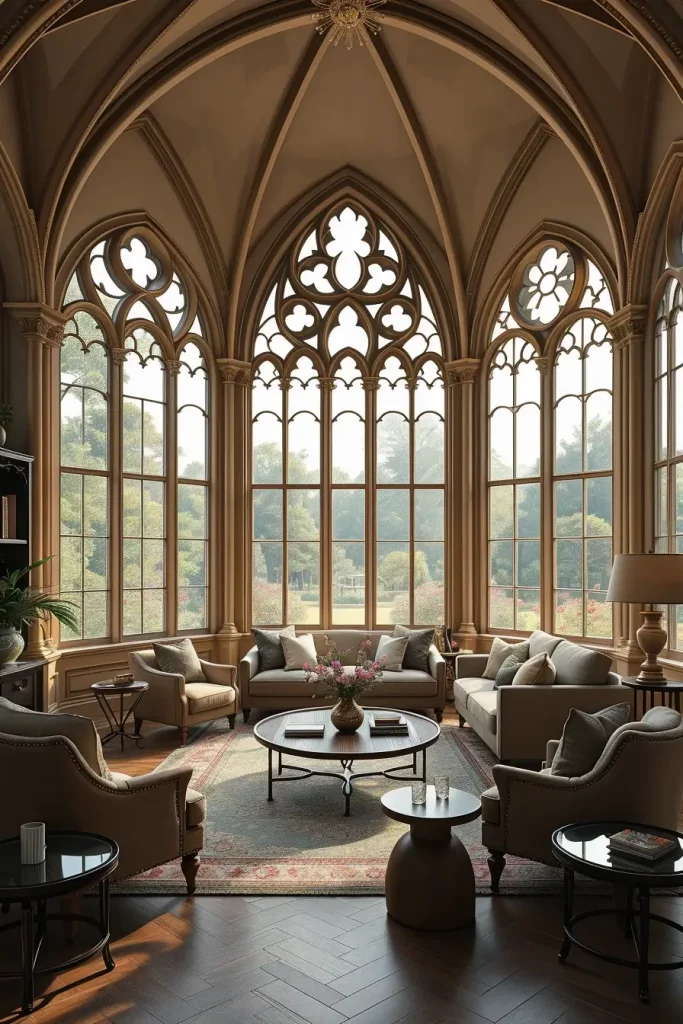
I tend to keep the furniture low and minimal around the windows when I design such spaces. This makes the outdoor view unobstructed Sofas with low backs, slim coffee tables and occasional chairs are very good.
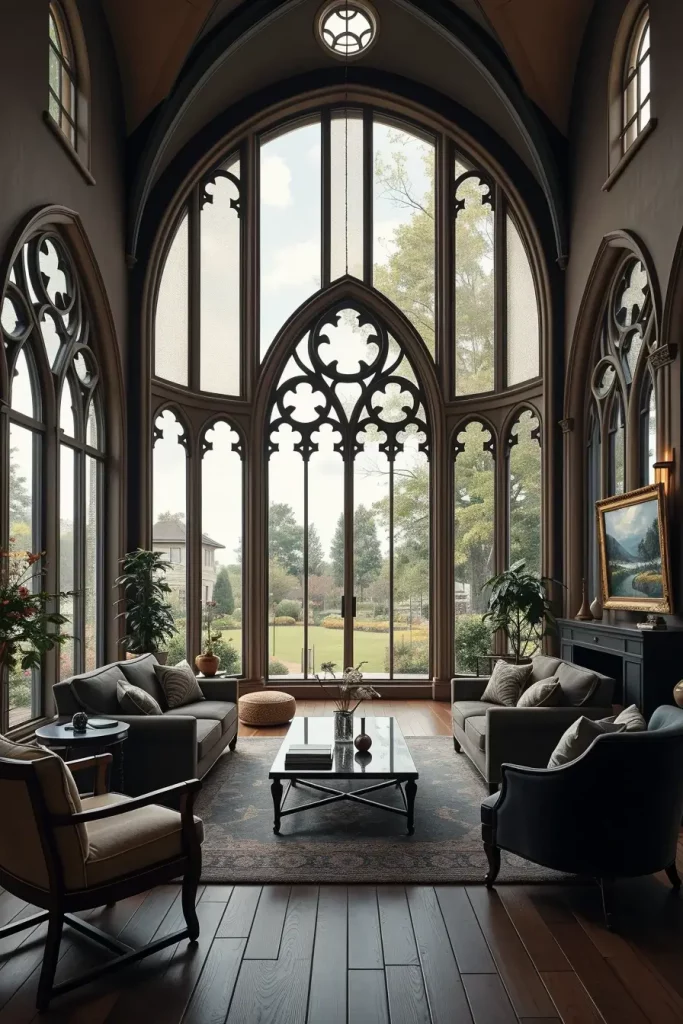
Personally I find that framed views are what makes gothic windows so interesting. A lot of contemporary architects stress the significance of natural views in interior design, as Architectural Digest explains, and I believe that gothic arches do it perfectly.
I would also suggest outdoor lighting to illuminate gardens or trees at night so that the view is equally spectacular at night.
Seasonal Decor Around Gothic Arched Windows
Seasonal decor is a great idea to update a gothic living room without changing its permanent structure. I frequently add wreaths, garlands and themed drapery accents to gothic windows to draw attention to them during holidays or changing seasons.
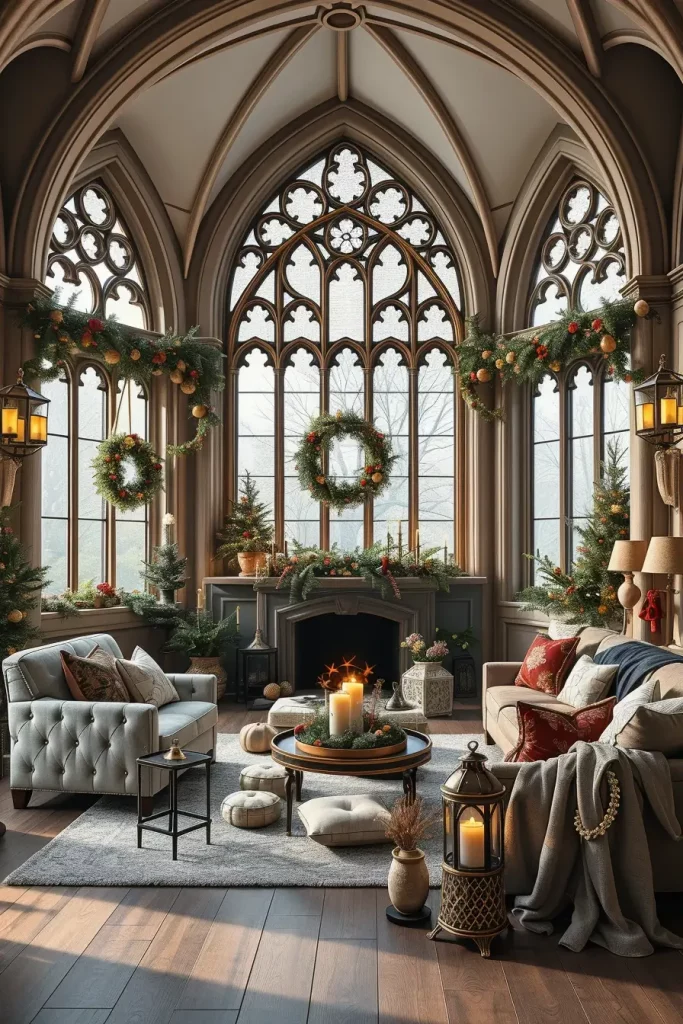
The furniture layout remains largely unchanged, but I prefer to add seasonal cushions, throws or centrepieces that match the window dressing. The finishing touch is usually iron candleholders or wooden ornaments which give a balance to the gothic structure.
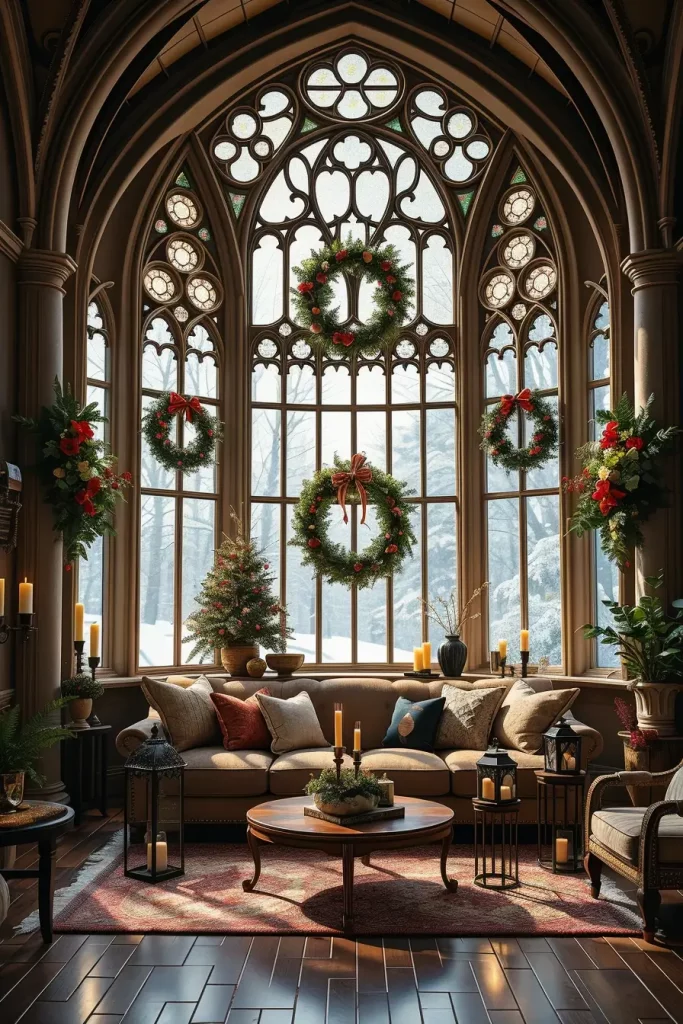
I believe that seasonal decor makes the room active and flexible. Magazines such as Better Homes & Gardens tend to emphasize the need to change interiors with the seasons in order to keep them interesting, and I believe that gothic rooms especially can use this.
I would recommend the use of subtle lighting, such as fairy lights during the winter and lanterns during the summer to give the arches a seasonal atmosphere.
Cozy Corners Formed By Small Gothic Windows
I have always liked the idea of smaller gothic windows as they make little nooks of space in an otherwise large room. The shape of the pointed arch leads the eye up, but due to their size, they do not dominate the interior. In a living room, smaller windows can be used to create a comfortable reading area or an otherwise neglected corner. They work particularly well in rooms with darker wall colors and the contrast between the frame and the wall can make the window look like it is glowing.
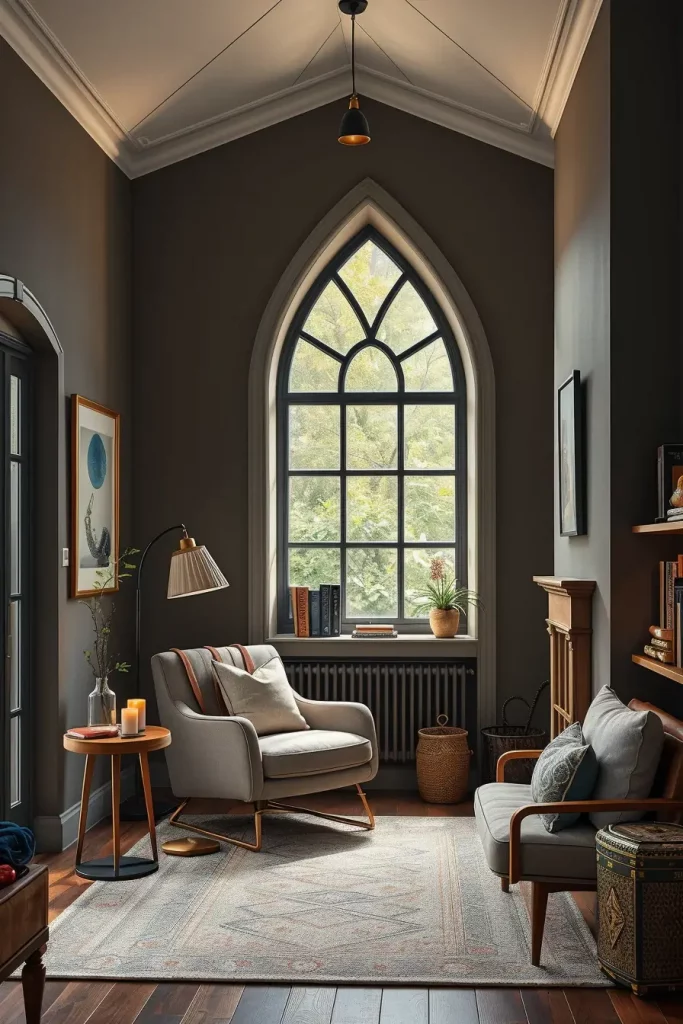
When I create such corners, I tend to include a soft armchair, a side table, and layers of textiles to further the effect of comfort. A bookshelf in the corner makes it more practical, and an overhead sconce or lampshape inspired by a candle helps to complete the picture. The furniture must match the gothic frame, and it tends to be rich woods, iron details, and deep fabric tones. These objects support the nature of the room without making it look old fashioned.
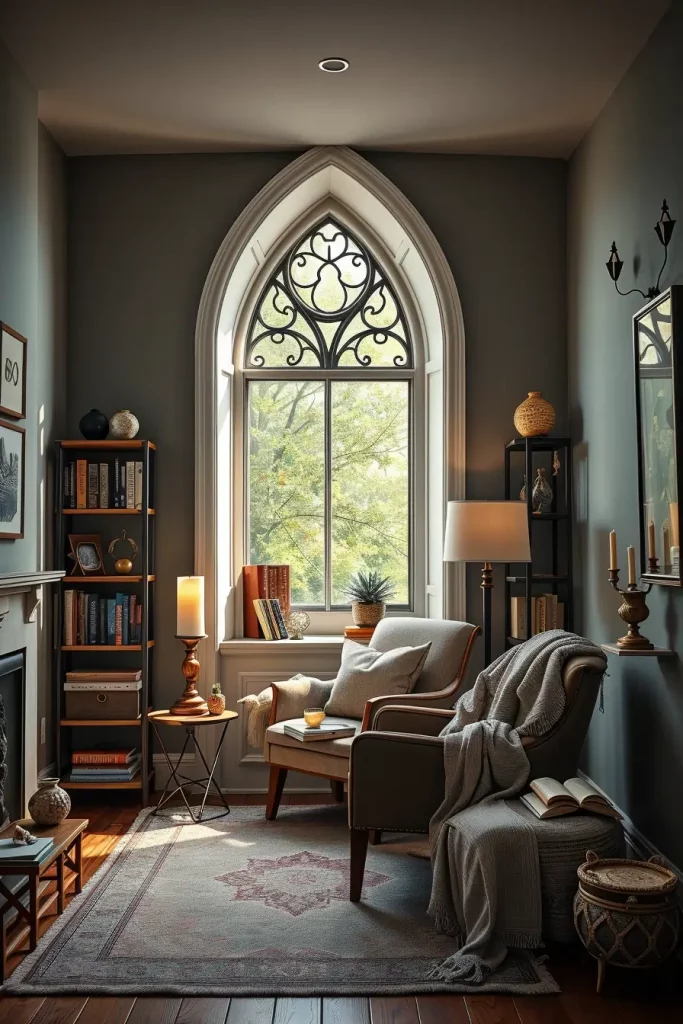
These types of corners are best when you offset them with natural light in my experience. Elle Decor says that small gothic windows can be used to make a place look welcoming when combined with reflective materials like glass tables or metallic accessories. I concur–mirrors and shiny surfaces reflect the light into the room, preventing it to be too dark.
To reinforce this part, I would also recommend the use of a decorative cushion bench beneath the window. This would enable the nook to serve as a reading area and a casual sitting area, which would make the design more flexible.
Transforming Apartments With Faux Gothic Arches
Not all people have a house with the real gothic elements, but it does not mean that they cannot enjoy the style. I usually advise faux gothic arches to clients who are living in apartments. These arches may be installed over existing doorways or as wall decoration, and can immediately add architectural flair without any structural work. They are particularly convenient to renters or homeowners with a tight budget.
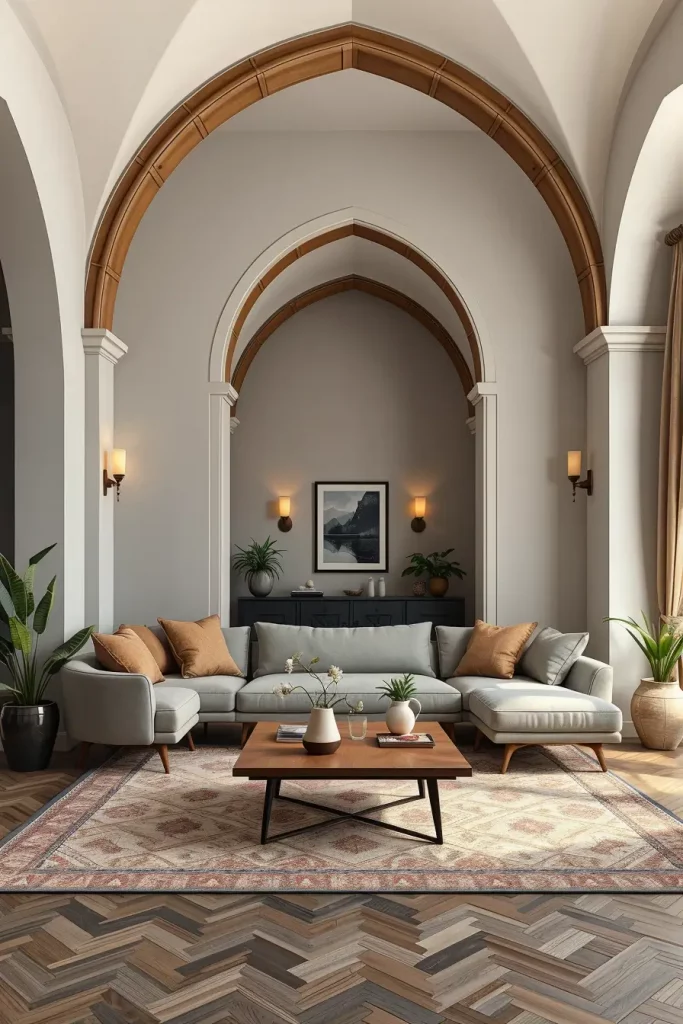
I think that contrasting these arches with modern sofas and low coffee tables helps to balance them. In case the arch is ornate, then the furniture must be simple and plain. In another case, when the faux arch is plain and simple, then you can add more detailed upholstery or patterned rugs to create depth. The concept is to have the arch as the focus and the other features as the supporting cast.
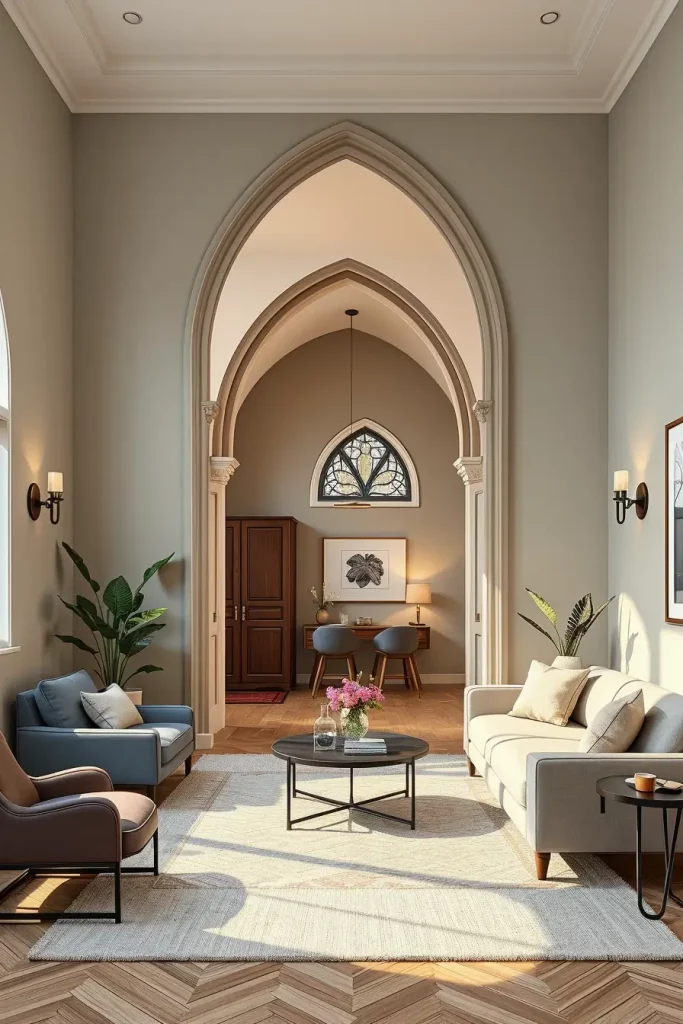
In my professional opinion, faux arches work best when they are painted to a different shade than the walls around them. This slight contrast creates an illusion of depth. Architectural Digest has reported that the use of arches as visual separators in apartments can actually make the apartment seem larger, which is what I have observed in real life projects.
I would include wall sconces or thin plants close to the arch to make the arrangement more dynamic. It would also assist in mixing the old-world gothic appearance with the modernity of living.
Artistic Touches To Highlight Gothic Windows
Gothic windows are not mere structural elements–they are areas of artistic expression. I prefer to use them as a frame to dramatic curtains, stained glass or even modern frosted inserts when I bring them to life in a living room. These accents can transform an ordinary room into something that is almost theatrical. They also give a chance to layer textures, which is one of the main design rules to make the interior look rich and balanced.
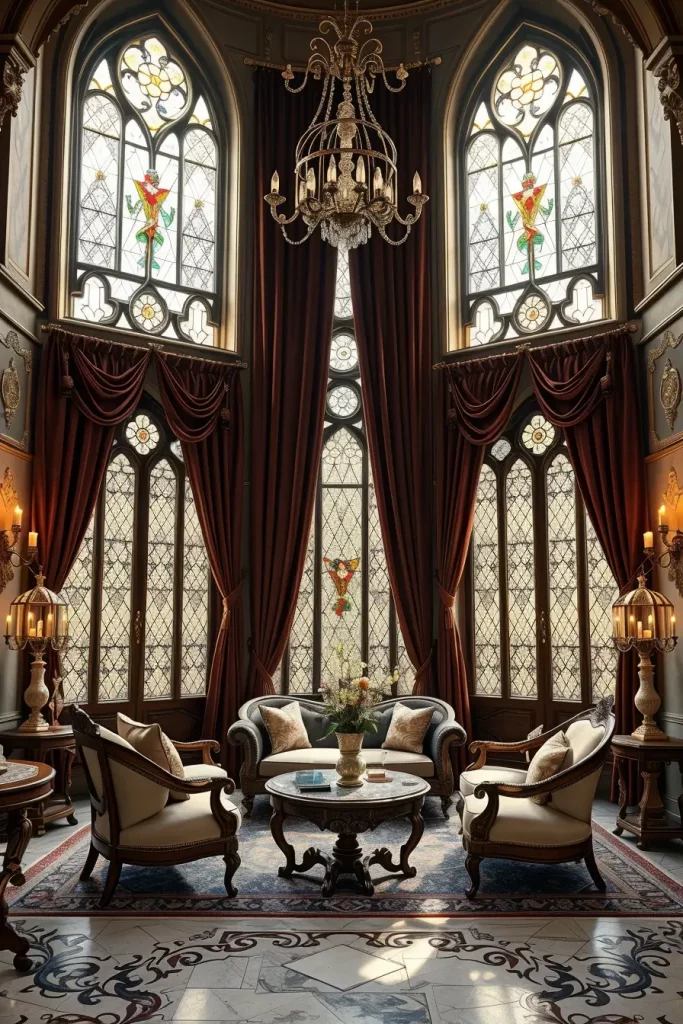
To go with such windows, I generally prefer long curtains of velvet or linen. A gothic-style chandelier above the room helps to bring the room together, and side chairs with carved wooden frames add to the historic feel. The gothic influence is further enhanced by adding accent tables with wrought iron bases or marble tops. These items of furniture must be selected with care, as they must not only blend with the drama of the windows, but must not make the space seem too crowded.
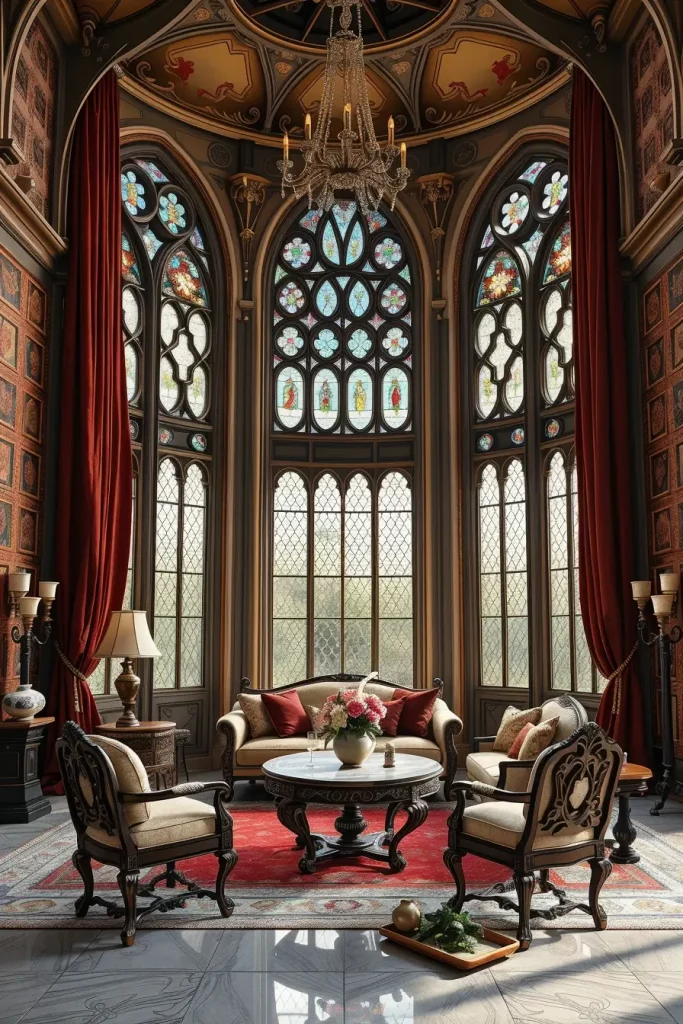
Personally, I have always liked how a gothic window can be used as the background to the main seating of a living room. Designers such as Kelly Wearstler tend to mention that architectural elements should not be concealed but rather embraced and I concur. Placing the furniture arrangement around these windows, you make them the natural center of the room.
What I would add to this is wall-mounted artwork that repeats the shape of the pointed arch. This repetition enhances the gothic aesthetic of the space so that the windows do not seem like an isolated design element.
Final Thoughts On Designing With Gothic Arches And Windows
To my mind, the real beauty of gothic arches and windows is their flexibility. They may be as delicate or as flamboyant as you like. No matter whether you are adding small gothic windows to create cozy corners or faux arches to modern apartments, each of the options can add richness and depth to the living room design. They are versatile and therefore a good investment in terms of style and ambiance.
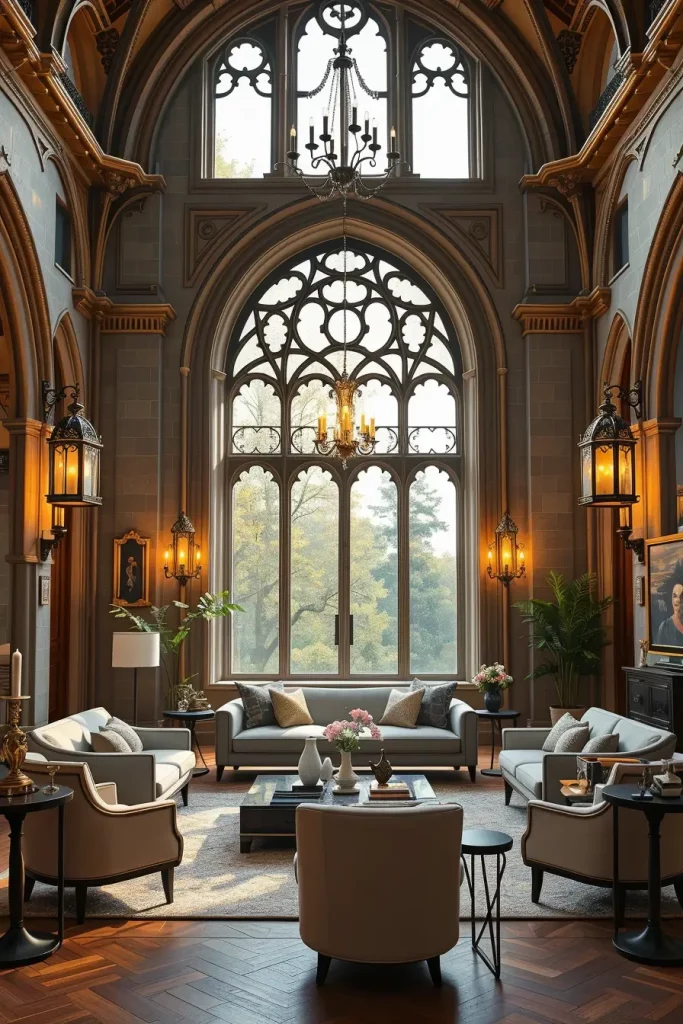
I would normally recommend beginning with a focal point, whether it is a large window or an imposing arch and then designing the rest of the living room around it. The sofas, chairs, and tables must be chosen keeping this focal point in mind, so that everything becomes coherent. Lighting is also an important factor; gothic elements are best when highlighted using warm lighting, so sconces, lanterns, and chandeliers are important factors.
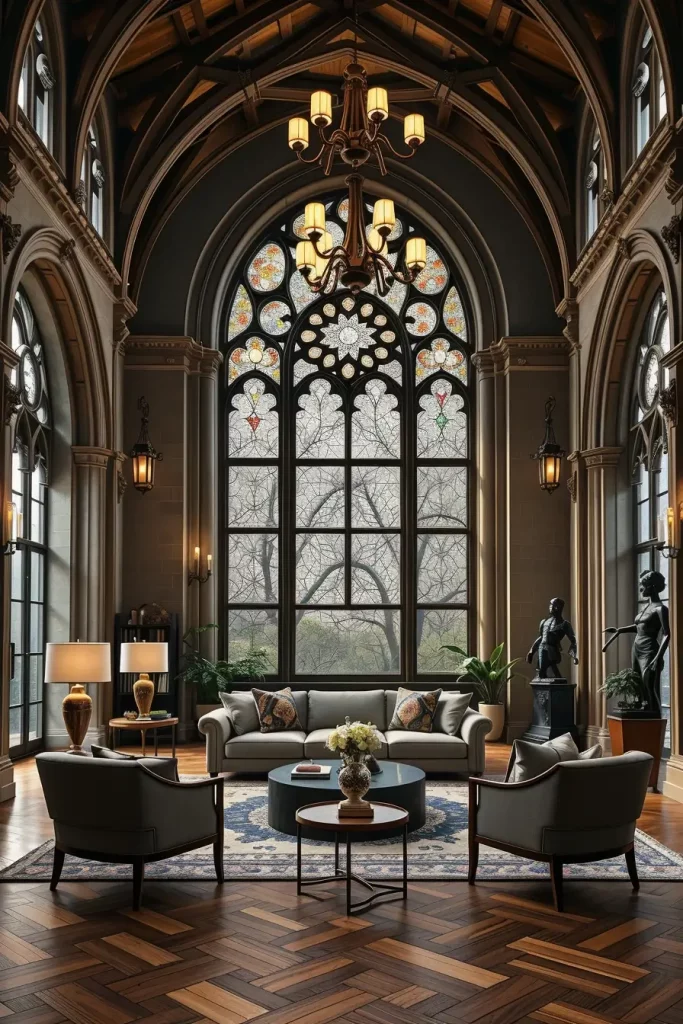
In my experience, the most effective gothic design is when it is coupled with restraint. There should be no excessive heavy pieces that can overpower the room, however, a few gothic elements will bring harmony. House Beautiful recommends using old architectural features with modern minimalist furniture as a sure way of creating timelessness, and I find that to be both accurate and practical.
The final tip I would give would be to add accessories to the design, candlesticks, sculptural decor, or textured pillows. These finishing touches cause the gothic style to not be so scary and more of a natural extension of your personality.
A gothic living room with arches and windows adds a dramatic and timeless feel to the room. These design features enable you to experiment with height, light, and balance to create a room that is extraordinary out of an ordinary one. Choose between original stained glass, large rose windows, or more contemporary versions of gothic arches, and you will add depth and character to your home. I would be interested to know what you think, how would you use gothic arches or windows in your own living room? Share your ideas in the comments below!
